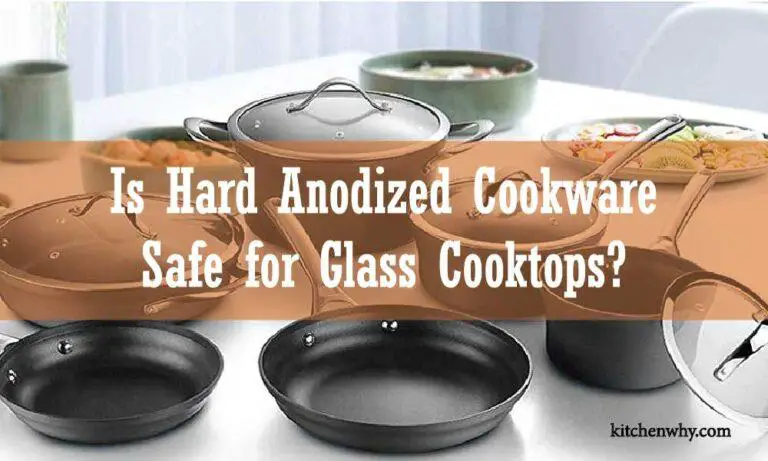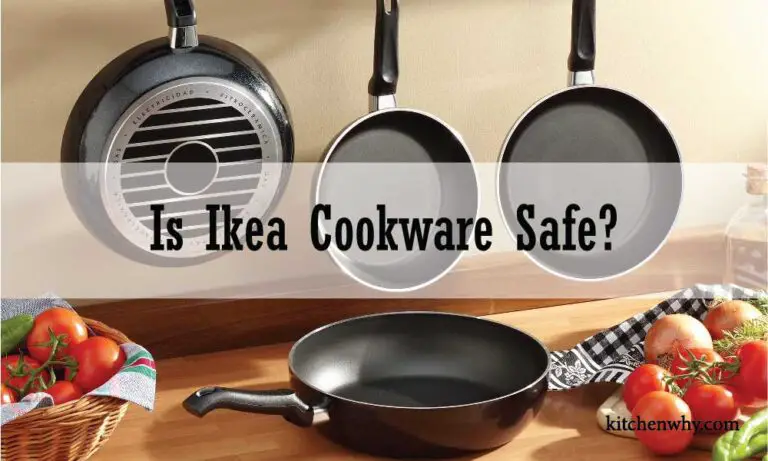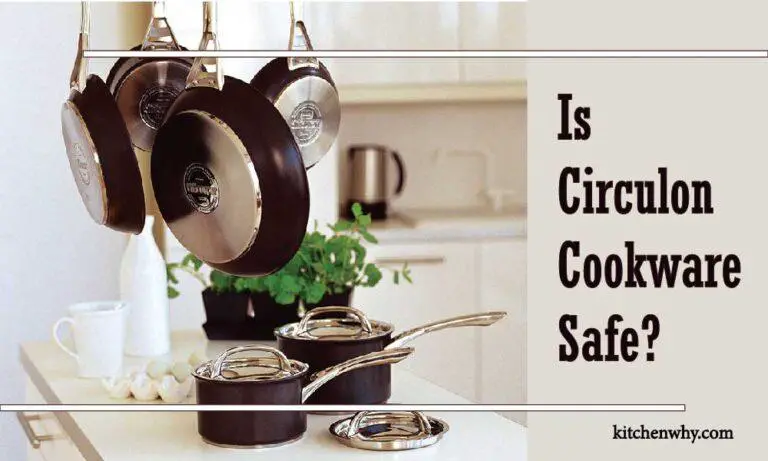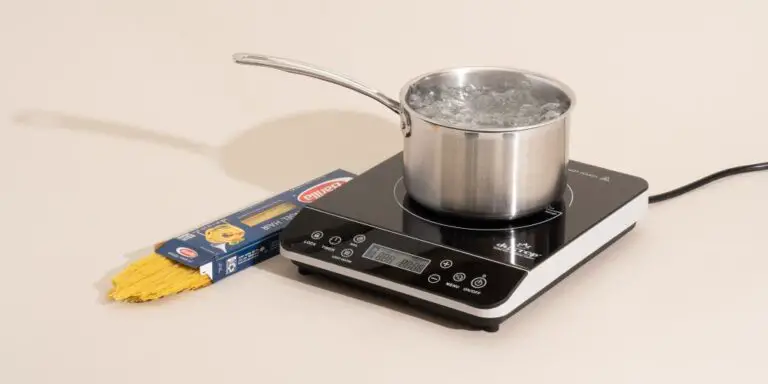Types of Cookware: An Overview

Ever wonder what cookware you should be using to cook with? Or how the different types of cookware can help you cook efficiently? Well, wonder no longer! We’re here to tell you all about the various types of cookware and how they can help you to cook. But before getting into that, let’s have a look at what cookware is and why it’s necessary.
If you’re looking for cookware that will offer you years of culinary pleasure, you’ll want to take a look at the variety of types available on the market today. From stainless steel to cast iron, there’s a cookware type perfect for every kitchen. In this blog post, we’ll discuss the different types of cookware and their unique benefits. We’ll also share our top picks for the best cookware sets available on the market today. So whether you’re in the market for new pots and pans or just want to learn more about the different types of cookware available, this blog is for you!
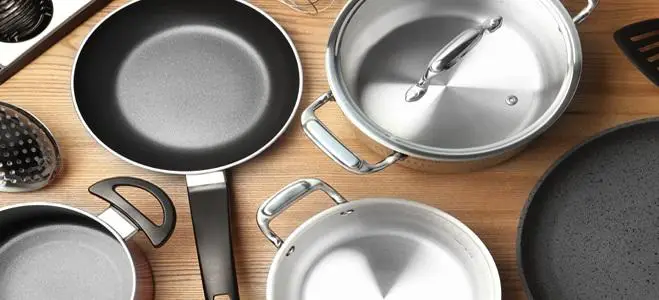
What is Cookware?
Cookware is any type of kitchenware that is used for cooking food. Common types of cookware include pots and pans, skillets, griddles, waffle makers, toaster ovens, Dutch ovens, and casseroles. Cookware can come in a variety of shapes, sizes, and colors, and it is usually made from metal, ceramic, or plastic. Each type of cookware has its own set of benefits and drawbacks.
Cookware is essential for every kitchen, as it helps to make food tasty and look beautiful. It is also useful for cooking multiple types of food at the same time which also can save our energy. In addition, cookware can be used to prepare meals ahead of time and store them in the fridge or freezer for later consumption.
Types of Cookware
Cookware can be made from a variety of materials, including stainless steel, aluminum, copper, and cast iron. Stainless steel is durable, non-reactive and versatile. Copper is a good conductor of heat, making it ideal for cooking foods that require high temperatures. Teflon is non-stick and easy to clean, but it does not conduct heat as well as stainless steel or copper. Cast iron cookware is heavy and takes a long time to heat up, but it is known for its even heat distribution. Lastly, glass cookware can be used on an induction stovetop, but it must be dishwasher safe. Some of the most popular types of cookware include:
1. Pots and Pans: Pots and pans are the most common type of cookware, and are used for both boiling water and cooking food.
2. Skillets and Griddles: Skillets and griddles are used for cooking food over a direct flame, such as in a stovetop or oven.
3. Stockpot: A stockpot is a type of cookware that is typically used for cooking soups, stews, and other liquids. It is typically cylindrical in shape and has a tight-fitting lid that seals in the heat and prevents moisture from entering the pot.
4. Roasting Pans: Roasting pans are used for baking meats or vegetables, and can also be used to cook eggs.
5. Sauté Pans: Sauté pans are used for cooking vegetables or meat in a skillet over medium-high heat.
6. Dutch Ovens: Dutch ovens are heavy-duty pots or pans made from cast iron that can be used for slow-cooking or braising foods.
7. Fryer: A fryer is similar to a skillet, but it is larger and designed for frying foods such as chicken or french fries.
8. Crockpot: A crockpot is similar to a Fryer, but it has a built-in timer so you can set it and forget it.
9. Custard Cups: Custard cups are small, round pots made from silicone that are perfect for making custards, ice cream, or other desserts in the microwave or oven.
10. Cake Molds: Cake molds are special pieces of cookware that are used to shape cakes or other desserts after they have been baked in the oven.
Types of Pots
There are different types of pots available in the market. Different pots are used for different types of cooking. Pots are generally used for heating and boiling liquids, so they have dual handles on both sides of the pot and are deeper than pans. Read on to learn more about the different kinds of pots used for cooking.
Stock Pot
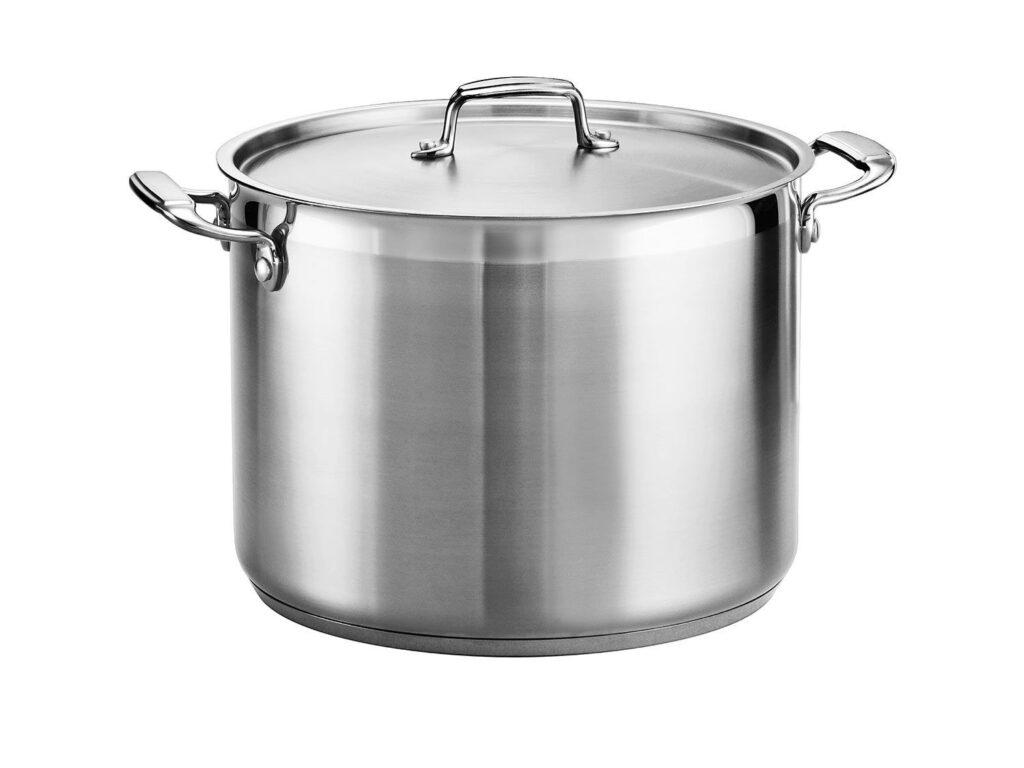
A stock pot, sometimes known as a large cooking pot, may be used to cook a wide range of recipes. It possesses a large base that encourages even low simmering while retaining fluids for longer. The liquids are forced to bubble up through the ingredients of a stock pot due to its shorter diameter. This pot is placed over high heat and stirred constantly to avoid sticking and ensure that the cooking conditions are as consistent as possible.
Highlights
- For a nice, slow simmer, it has a thick base.
- To cook food with steam, steam baskets are often used in stock pots.
- Soups, stocks, pasta, large vegetables, and seafood are all ideal candidates.
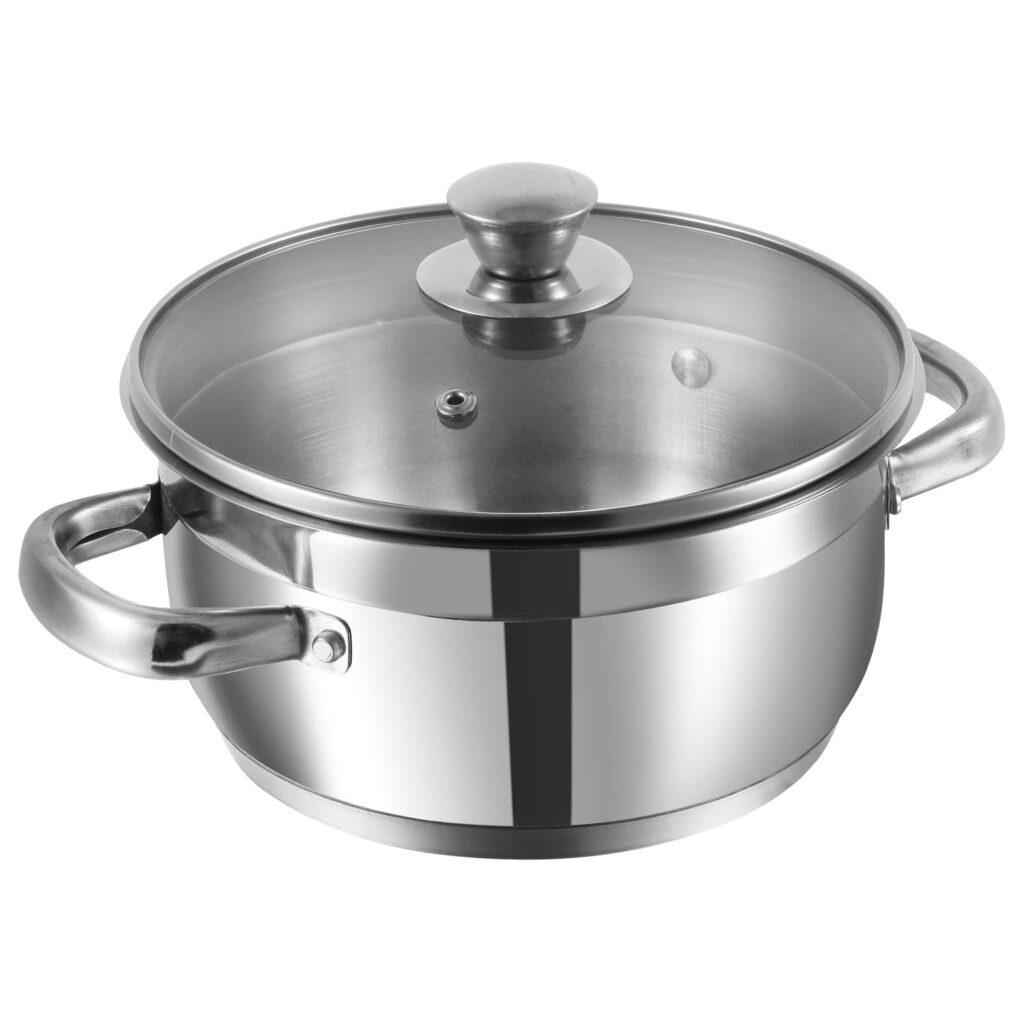
Sauce Pot
To encourage the reduction of liquids, a sauce pot has a similar shape to a saucepan, but it has a wider volume, steeper edges, and greater base for preparing larger amounts of sauces. Slow-cooking and simmering sauces, such as pasta sauce, are ideal.
Highlights
- For maximum heat conduction, the pan has a wide bottom area.
- For easier pouring and movement, two loop handles are used.
- Ideal for slow-cooking sauces and soups while reducing the amount of salt and sugar.
Brazier
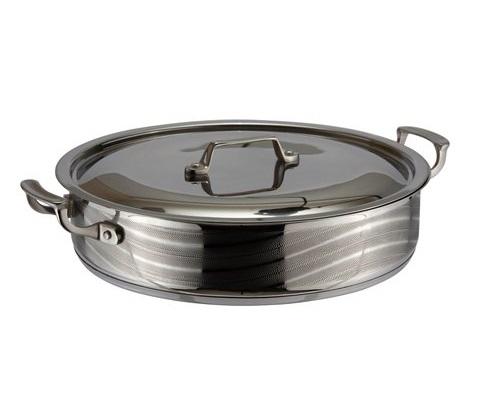
Braziers, also known as rondeau pans, are ideal for braising meats, veggies, and legumes because of their shallow height and large cooking surface. The high sides of the pan create a very high oven-like heat, which can cook meats evenly and prevent them from sticking to the pan. For even cooking, braziers have a long handle on one end and two loop handles on the other so that you can easily move it around while cooking.
Highlights
- The deep dish shape means that there is more surface area for searing meat before braising or roasting it.
- The cooking of meats and vegetables in limited amounts of liquid is possible due to the wide heating surface.
- Ideal for cooking in a slow cooker for a long period of time, allowing the liquid to cook and enhance flavors.
- To allow for versatility, the dish is normally oven-safe.
- Each side of the handle has a grip.
Pasta Pot
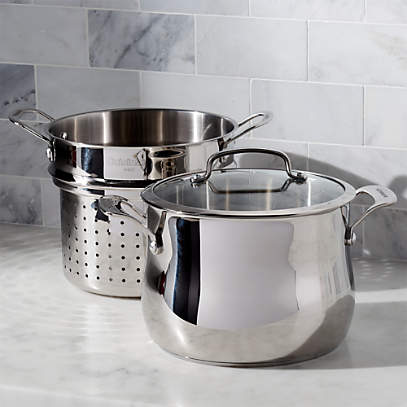
Fitted strainers are included with pasta cookers, making cooking pasta easier. After your pasta is cooked, simply take it out of the hot water with the strainer basket. The baskets are also ideal for steaming vegetables and seafood, allowing you to keep the food inside while filtering out water, oil, or other liquids.
Highlights
- A tall pot with a detachable perforated basket is included to hold food.
- Excellent for cooking pasta, seafood, and veggies.
- Easy movement and transportability are provided by the handles.
Dutch Oven
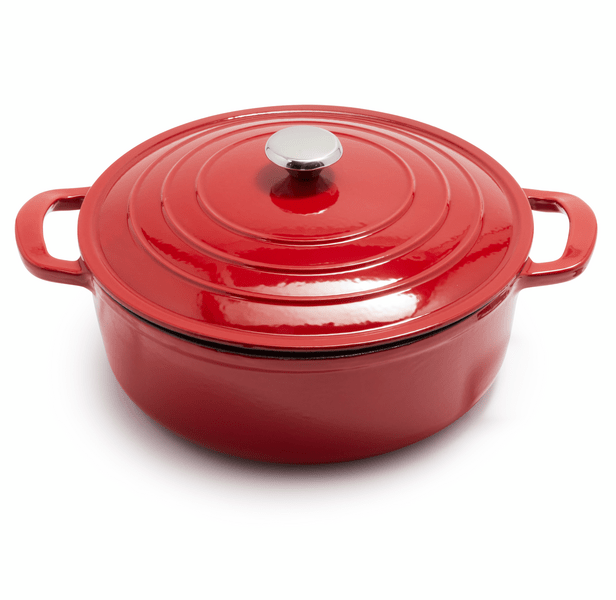
Heavy, wide, and rather shallow cookware with thick, curving walls and tight-fitting covers are known as Dutch ovens or cocotte pots. They are popular for slow-cooking or braising foods because they retain moisture well. Unlike stock pots that have straight sides with a relatively large base, Dutch ovens have curved sides with deep indentations resulting from centuries of hand-hewing by stonemasons who used the Dutch oven for baking bread dough and roasting chickens. The curved sides distribute heat more evenly and cook food slowly, resulting in juicy and flavorful foods.
Highlights
- To cook foods uniformly, heavy weight is used to maintain consistent temperatures.
- In addition to enameled cast iron and cast aluminum,
- Braising, searing, simmering, and baking are all best done with this pan.
- Induction-ready and oven-safe
Fryer Pot
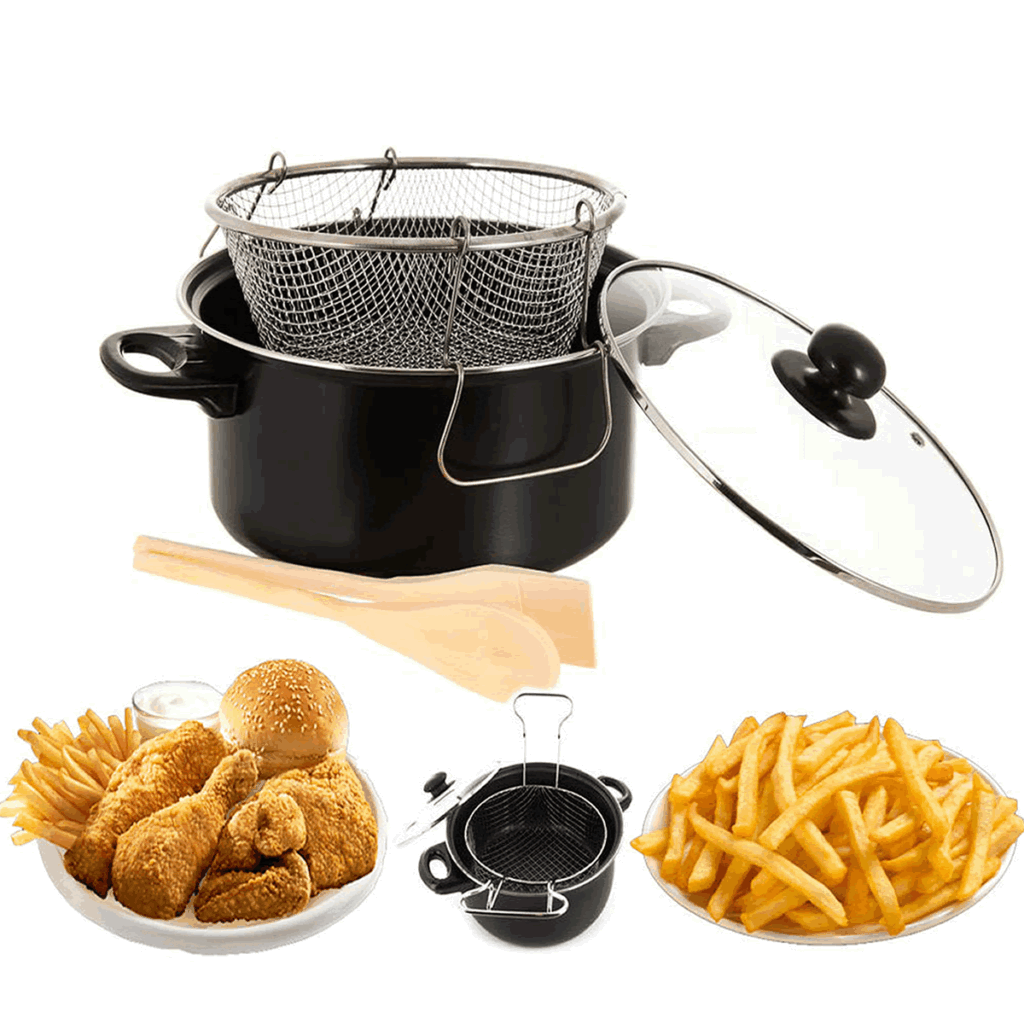
For households that don’t have a deep fryer but want to offer modest batches of fried food, a deep fryer pot is an excellent choice. A draining basket may simply be connected to them by means of a side hook. These pots come in all shapes and sizes, but the most popular ones are 12-inch frying pans with a 5- to 7-quart capacity. They have deep sides that help keep fryer oil hot while cooking foods, lightweight aluminum or stainless steel constructions for easy transportability, and slotted griddles on top that make it easy to turn over foods.
Highlights
- The wide bottom allows for excellent heat transfer, while the high sides allow for maximal capacity and safety.
- To remove foods from hot liquid, use a draining basket.
- Ideal for cooking classic fried foods such as French fries, chicken fingers, and mozzarella sticks.
- The pot is large enough to cook multiple batches of food at once.
- Constructed from durable materials for long lasting use.
Crockpot

If you’re cooking for a smaller group of people or don’t have the time to spend in the kitchen, consider using a crockpot. This type of cooker is perfect for large quantities of slow-cooked foods like pot roasts, stews, and casseroles. They come in different shapes and sizes but all include an oven-safe housing that can hold up to three quarts. Crockpots heat food slowly on low temperature settings so it becomes tender and juicy with long lasting flavors.
Highlights
- Ovensafe housing means you can cook meals in the oven without having to remove the pot.
- Heats food slowly on low temperature settings so it retains its moisture and flavor.
- Ideal for cooking large quantities of slow-cooked foods that will be enjoyed by a smaller group of people or over extended periods of time.
- Crockpots are affordable, durable, and easy to clean.
Double Boiler

A double boiler is a temperature-sensitive device that has two containers: an inner and an outer one. It’s also known as a Bain Marie. To cook or melt food, a double boiler employs steam as a heat source. The inset fits securely into the pot to cook the food gently but effectively with steam, and the boiler pot is designed to hold water. A high-quality stainless steel double boiler will heat quickly and evenly, making it a versatile piece of cookware for stovetop cooking. They come in different sizes from 2 quart to 11 quart, with capacities ranging from 3 to 12 quarts. The pot has two openings (one on the bottom and one on top) that make adding or removing ingredients easy. It also comes with a long handle for upright use, as well as an oven-safe temperature range of 350 degrees Fahrenheit to 550 degrees Fahrenheit.
Highlights
- Heats quickly and evenly.
- Ideal for stovetop cooking.
- More sensitive foods are heated by combining pot, inset, and cover work.
- Sauce and chocolate melting are ideal for this pan.
- Both the boiler and the inset have exterior handles for transportation.
Types of Pans
There are a variety of pots and pans available on the market today. Pans are typically flatter than pots and have one long handle. They’re utilized for sautéing, frying, searing, and reducing at elevated temperatures. From cast iron to stainless steel, copper to aluminum, there is a pan for every type of cook. Some pans are made from heavy-duty materials, while others are lightweight and durable. Each pan has its own unique features that can make cooking easier and more efficient. Read on to learn more about the different kinds of pans used for cooking.
Fry Pan
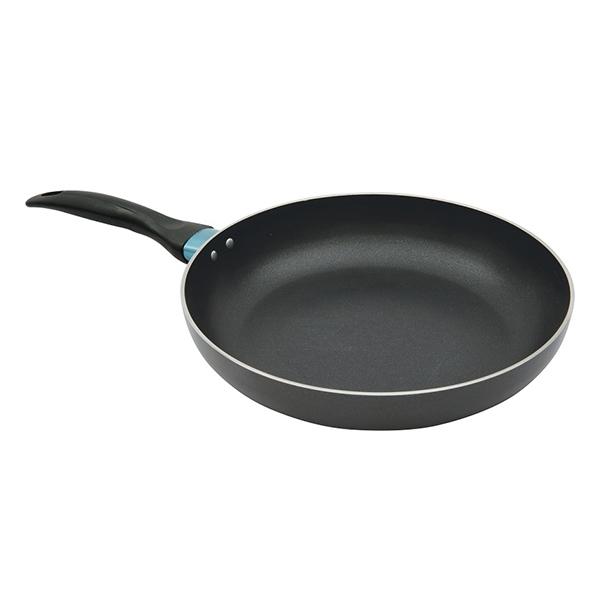
Every restaurant should have a couple of fry pans in its cookware arsenal because they are an essential kitchen smallware. They’re good for tossing foods in the pan to evenly cook them, and they have a spherical form with moderately high, slightly sloping edges. This type of pan is best for cooking at high heat, because the rugged construction prevents aluminum from reacting with foods.
Highlights
- For simple stirring and sliding of food out of the pan, the curved side walls are helpful.
- Steam cannot build up in the pan due to sloped edges.
- The long handle allows for easy food handling while keeping hands away from the heat.
- Frying, browning, scrambling, sauteing, and searing are all good uses for it.
Sauté Pan
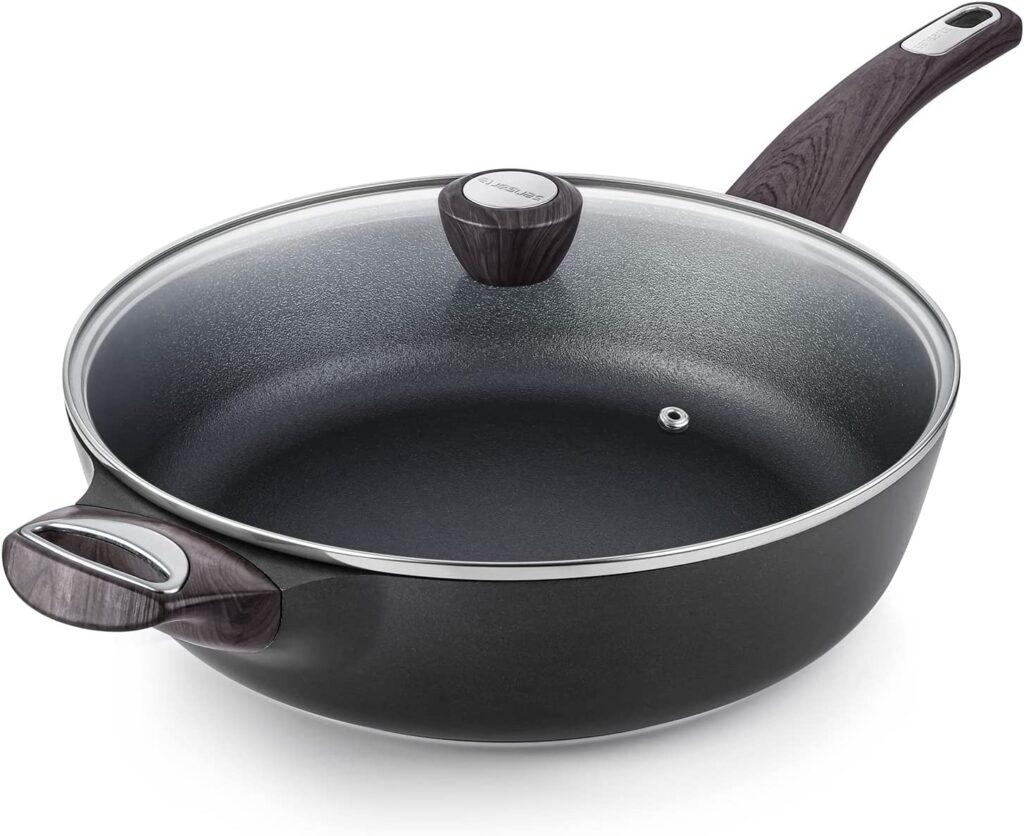
A wide, flat bottom and steep, vertical sides characterize a sauté pan. By enabling the pan to hold more liquid without the danger of it overflowing over the edges, the straight sides enhance its cooking area. This pan is ideal for searing or heating foods over high heat. The long handle also makes it easy to cook with both hands free while keeping a close eye on the food.
Highlights
- The straight sides and deep dish help prevent sauce from spilling out of the pan and making a mess.
- The tall sides provide good stovetop BTUs, so you can cook at higher temperatures without fear of burning your food.
- For optimum heat transfer, there is a large bottom section.
- The straight, high sides help to contain and expose food to heat.
- The lengthy handle enables for easy handling of food while preventing hands from getting burnt.
- Sauteing, searing, braising, deglazing, poaching, and stir-frying are all ideal uses for it.
Sauce Pan
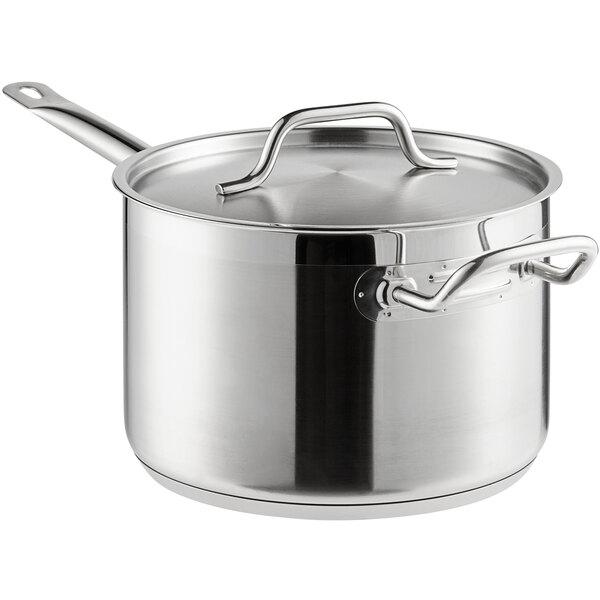
To promote reduction, saucepans have tall sides and narrow bases that heat liquid ingredients from all sides. Saucepans are the finest device for creating a variety of sauces, however they may also be used to cook and boil liquids in. Maximize heat conduction in a straight-sided saucepan with a wider bottom or minimize it in a tapered saucepan with smaller bottom and flared edges.
Highlights
- With a long handle, this lightweight design is ideal.
- This is ideal for cooking at lower temperatures for a long period of time.
- Sauces are best made and reduced.
- Vegetables can be cooked in it, and liquids may be heated.
Cast Iron Skillet
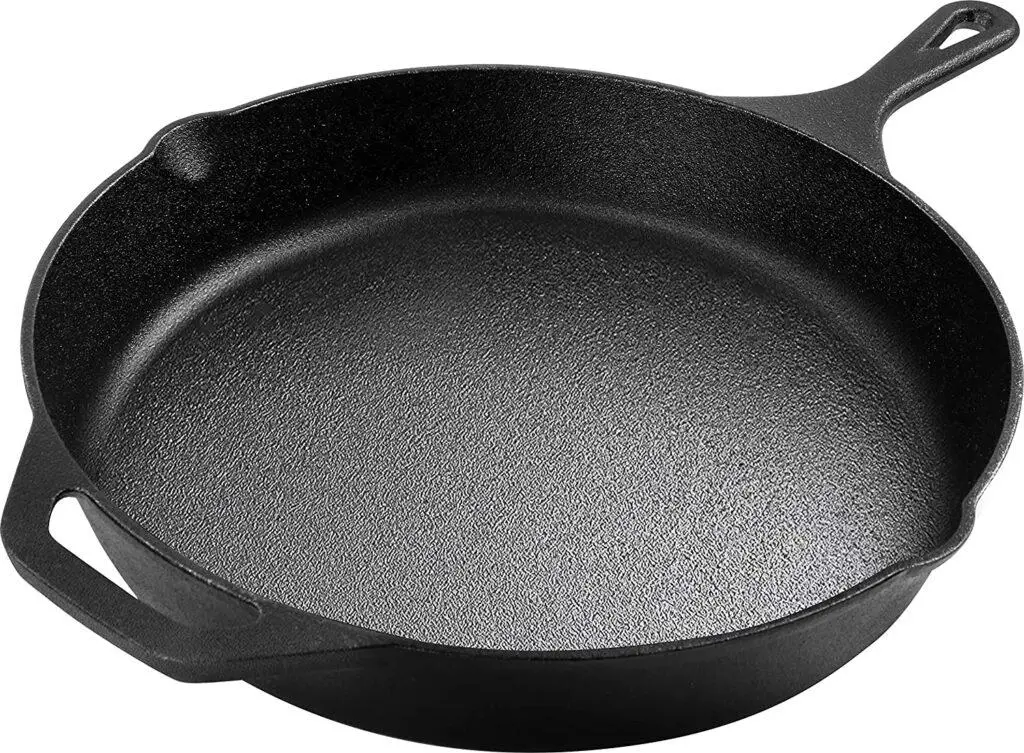
From searing steaks and bacon to baking a fruit cobbler or cookie cake for that perfect crust, cast iron skillets can be used to cook a wide range of dishes. Cast iron has a unique ability to transition from stovetop to oven to table, making it unparalleled in terms of versatility. Cast iron is also nonstick, so foods cook evenly and there’s never any need to worry about sticking.
Cast iron pans heat slowly and require long stints in the oven or stovetop to achieve high temperatures, so cast iron is not recommended for cooking at high speed.
Highlights
- Foods cook better with less risk of scorching since cast iron heats evenly and consistently without “hot spots.”
- It is simple to transfer from the stovetop and/or oven to the table for fast, hands-free service with less cooking utensils.
- With regular cleaning and upkeep, it can last a long time.
- Sauteing, searing, frying, and even baking are all excellent uses for it.
Wok
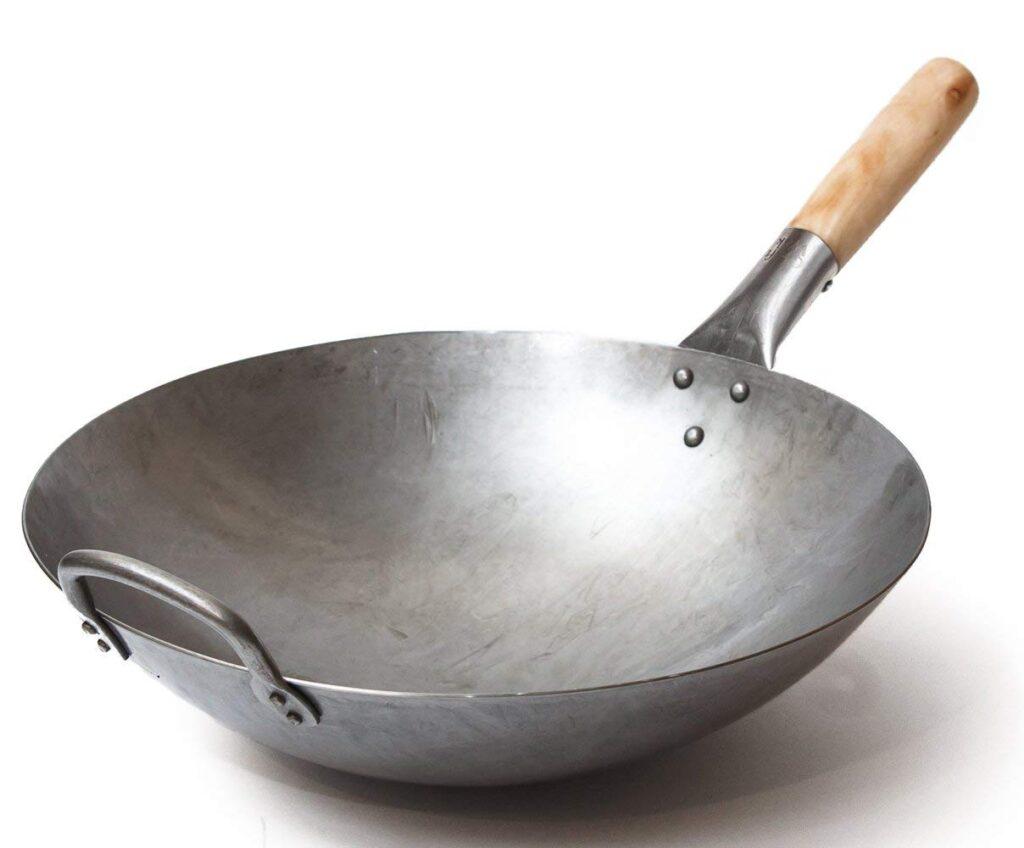
Woks are Asian cookware with a large bowl that has steep, high walls for cooking foods from all sides of the pan. The even heat distribution of a wok helps to cook food quickly and thoroughly, which is one of the many advantages. While flat-bottomed woks are available for use on traditional cooktops, they are traditionally round-bottomed to cook on a wok range. Woks are versatile cooking utensils that can be used for boiling water, stir-frying, or even deep-frying.
Highlights
- For maximum heat concentration, feature rounds or flat bottoms.
- It’s simple to toss food with its wide curved sides.
- Ideal for stir-frying and sautéing.
- In Cantonese woks, there are two loop handles, whereas in Mandarin woks, there is just one standard handle.
Tawa
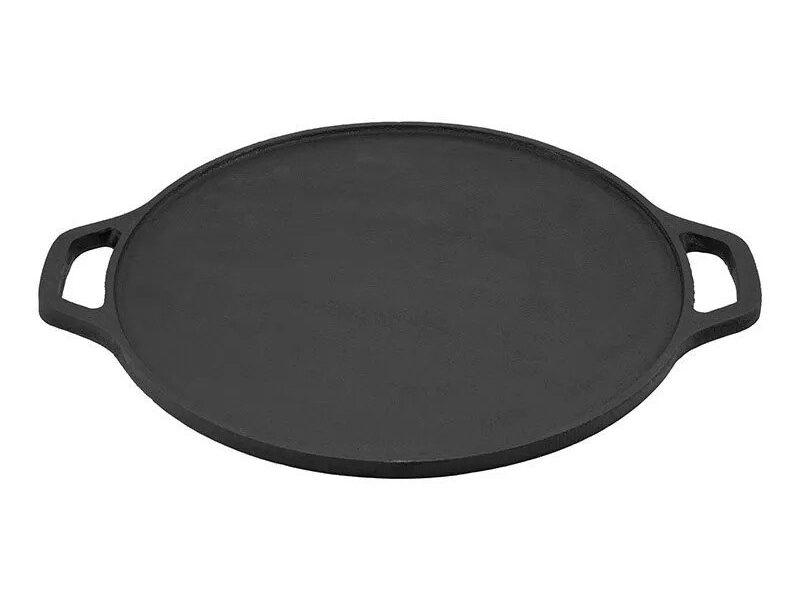
A tawa is a type of griddle that is popular in Indian cooking. The nonstick coating makes it easy to cook without making any mess, and the stainless steel surfaces ensure even heat distribution. It’s lightweight so you can easily move it from stovetop to oven and handle easily. It is also made from cast iron which have non stick surface.
Highlights
- The nonstick coating means no food sticking to the pan.
- The griddle sides are adjustable for different sized pans or foods.
- Stainless steel or cast iron ensures even heat distribution across the surface of the pan.
Roasting Pan
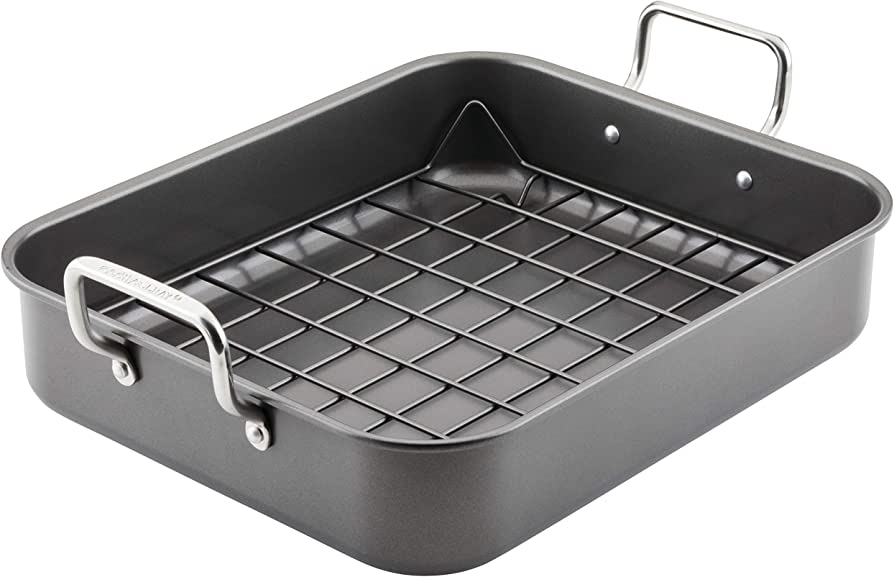
Roasting pans are used to cook whole turkeys and chicken, as well as roasts, and they come in a variety of sizes. They have a flat bottom and shallow sides and are usually rectangular. They may additionally be employed to bake cinnamon rolls or roasted veggies. Roasting pans heat up slowly and evenly, which means that foods cook more gently and retain their moisture.
Highlights
- The handles make it simple to load and unload the oven, as well as carry it.
- The shallow edges enable for efficient heat distribution.
- Roasts, hams, and turkeys are all accommodated by heavy-duty construction and large size.
- Steel or aluminum are commonly used to make them.
Paella Pan
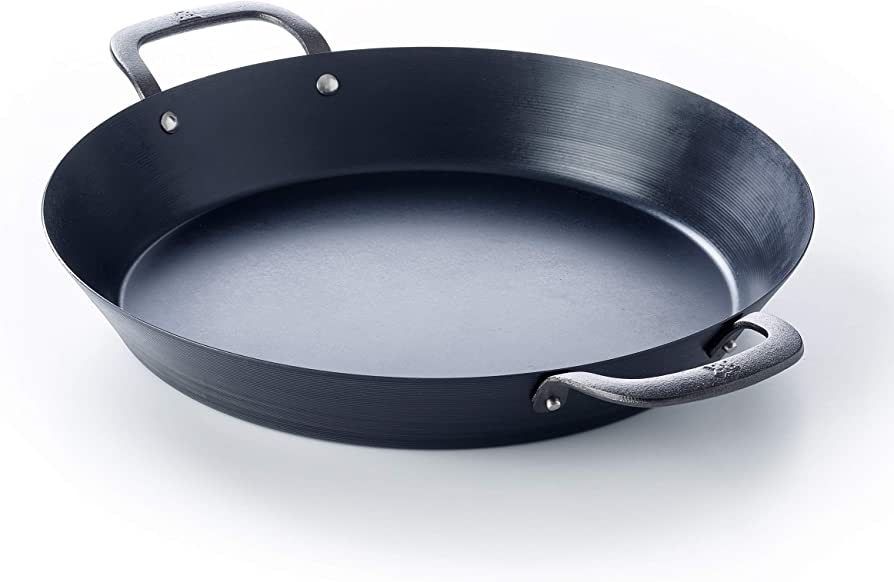
You can see all of the ingredients in your dish and stir them frequently because a paella pan is designed to be shallow. The paella cooks evenly and toasts rice on the bottom of the pan due to its shallow design and sloping edges. The paella pan also has deep sides which prevent the rice from sticking to the bottom of the pan and makes stirring easier.
Highlights
- The nonstick coating means it is easy to cook without making any mess.
- The handles on both sides are independently adjustable.
- It’s compatible with all kinds of heaters.
- Steel or aluminum are often used to make them.
Types of Bakeware or Baking Dishes
Baking pans are valuable for delis, restaurants, eaters, and any other business that wants to make and serve homemade products. They’re not just required for bakeries. When picking out your baking pan, material, size, and color all affect bake time and outcomes, it’s important to keep that in mind. So that you may choose which baking pans are the finest addition to your restaurant kitchenware, we’ll go over different kinds of baking pans.
Bread and Loaf Pan
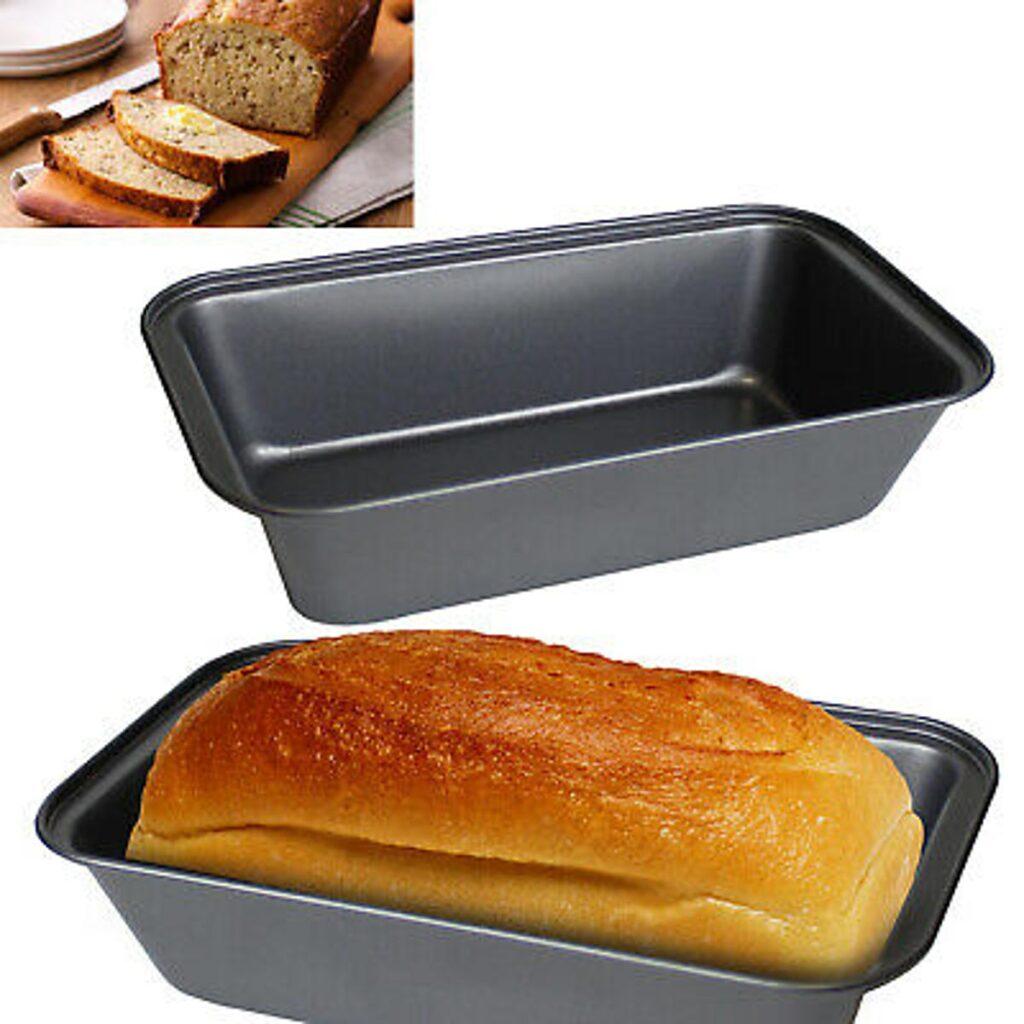
Any bakery, sandwich shop, or cafe that makes house-made specialty bread will need bread and loaf pans. In addition to traditional bread loaves, bread pans come in a variety of mold shapes and sizes for making French bread, sandwich rolls, and buns.
Highlights
- The ability to rise high is a result of the deep structure.
- Bread, cake, and pudding are all perfect candidates.
- Low-temperature baking for optimal effects is possible due to excellent heat convection.
- Bread and rolls cook evenly due to the even heat distribution.
- Mold shapes range from round, oblong, and square; this ensures that you’ll have a pan that’s specifically tailored for your needs.
Sheet Pan

In any bakery, restaurant, or catering company, sheet pans are one of the most commonly used pieces of bakeware. The flat construction ensures even browning and baking, and the thin sheet is ideal for baking cookies, rolls, and other foods that don’t produce a lot of liquids. To enable for easy food product removal, the majority of these pans have non-stick surfaces or silicone glazes.
Highlights
- Baking, broiling, cooling, and storing food are all possible uses.
- Products do not slip off due to upturned lips, making them easier to handle.
- There are a variety of sizes and rim depths to choose from.
Angel Food Cake Pan
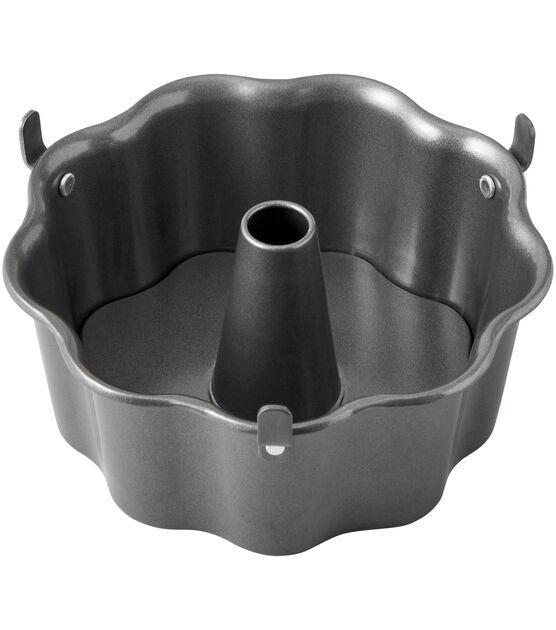
Angel food cake pans have large edges, smooth surfaces, and a tube in the center that’s ideal for angel food and Bundt cakes. Non-stick coatings are used on several of the pans to help the cakes achieve their light and fluffy texture. Several have a detachable bottom that makes cake removal and cleaning easier.
Highlights
- The hollow core of the tubular design helps to evenly heat.
- Angel food and bundt cakes are perfect candidates for this method.
- The cake rises thanks to straight sides and a non-stick surface.
Cake Pan
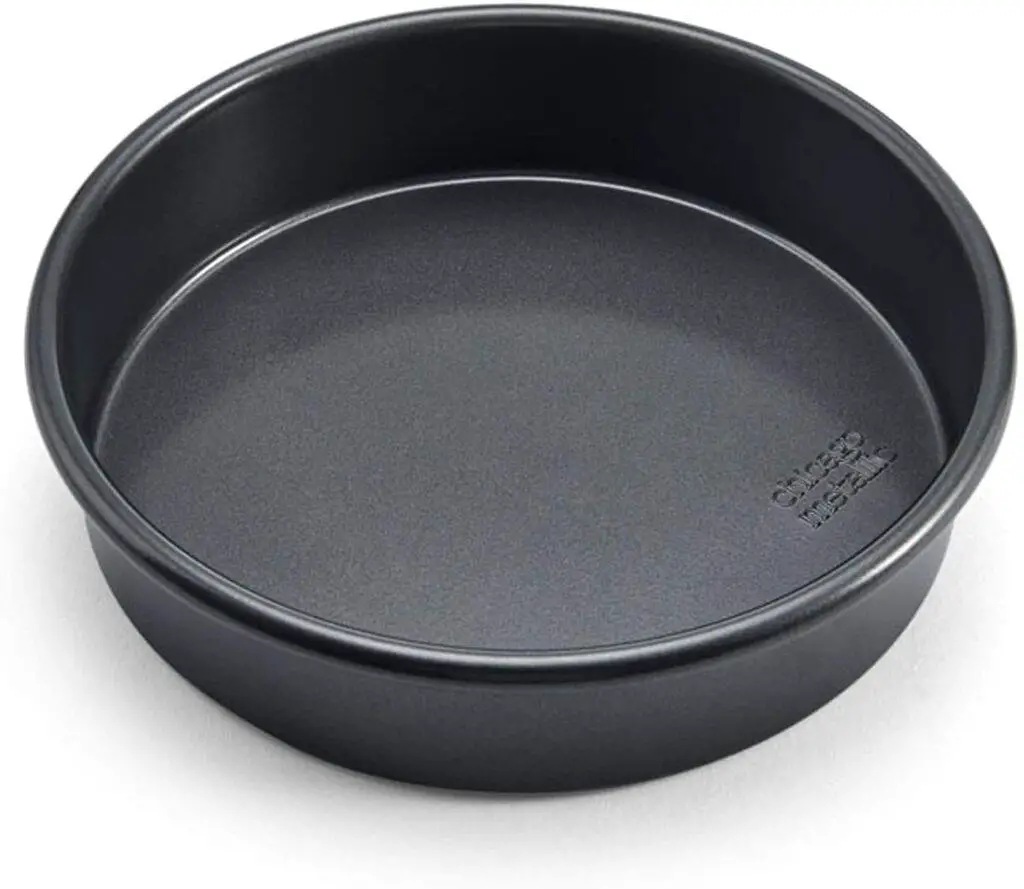
Your batter is held in the oven by cake pans, which mold it into flawlessly shaped cakes. The ideal texture and rise are derived from their tall, straight sides and flat bottoms. The appropriate kind of cake pan is critical to your recipes, depending on the cake style and serving size you want to provide. To quickly heat and evenly bake cakes, many cake pans are made of aluminum.
Highlights
- For a clean and simple release, straight side walls are used.
- Ideal for baking cakes and large pizzas, this pan is durable.
- Heat quickly, then cool quickly.
Muffin Pan
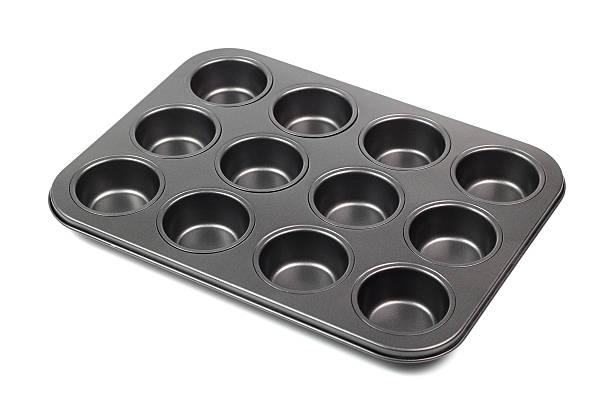
To offer durability in high-volume restaurants, commercial muffin and cupcake pans are fashioned from aluminized steel, aluminum, cast iron, and sometimes silicone. Some have non-stick glazes and reinforced rims to help with cleaning and release.
Highlights
- For small, medium, and big-sized muffins and cupcakes, this is an option.
- Egg cups, mini quiches, and tarts can be baked in this way.
- Models with 6 to 48 cups are available for high-volume productivity.
Springform Cake Pan
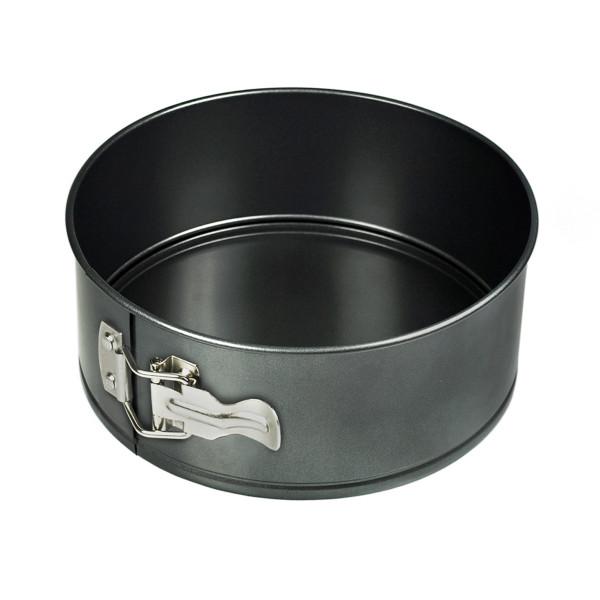
A cake pan with a detachable bottom that fits to its sides via a sprung collar is known as a springform pan. They’re intended for use with delicate foods that are difficult to extract or rotate from the pan. When making delicate baked goods like cheesecakes, ice cream cakes, tortes, and others, use a springform pan to ensure a flawless end result.
Highlights
- For an easy release, the table is made up of two pieces with detachable sides.
- Ideal for cheesecake, tortes, quiche, and other recipes that may be tough to remove from a standard pan.
Pie Pan
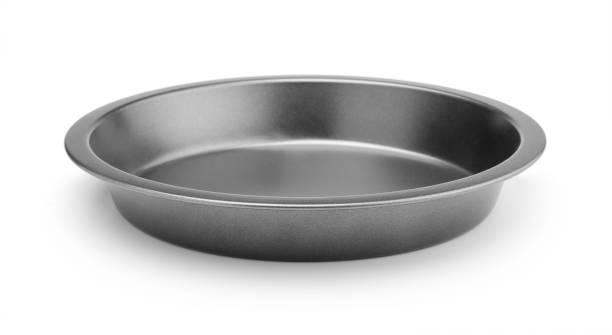
Tin or aluminum pie pans are ideal for heat transfer and uniform browning. In addition, they reduce the risk of shattering glass or China cookware in high-volume bakeries and eateries. Glass or China pie pans are ideal for displaying in your bakery window or case because they give a visually appealing presentation.
Highlights
- The crust cannot slump because of the angled sides.
- Fluting is made simple by the wide rim.
- There are two types of standard depth and deep dish available.
Tart Pan
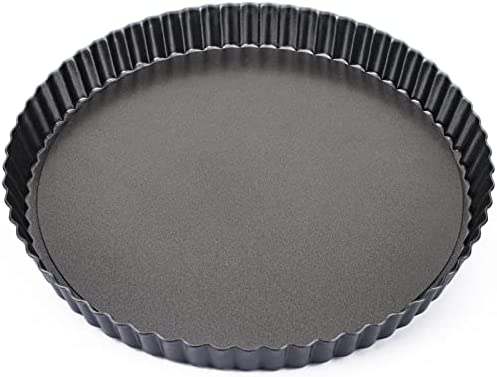
Baked dessert tarts, morning quiches, and small pies all have perfect crusts that are formed using a tart pan. Some have a detachable bottom that enables you to easily remove the outer ring without leaving any marks on your baked goods.
Highlights
- The fluted sides make artisanal crust production simple.
- From little tarts to great quiches, you can create a wide range of products with a variety of sizes.
Cookware Materials
Now, let’s look at the various cookware materials available. To ensure you have the appropriate pot or pan for your recipe, it’s likely that you’ll need cookware and bakeware in a variety of materials.
Stainless Steel Cookware
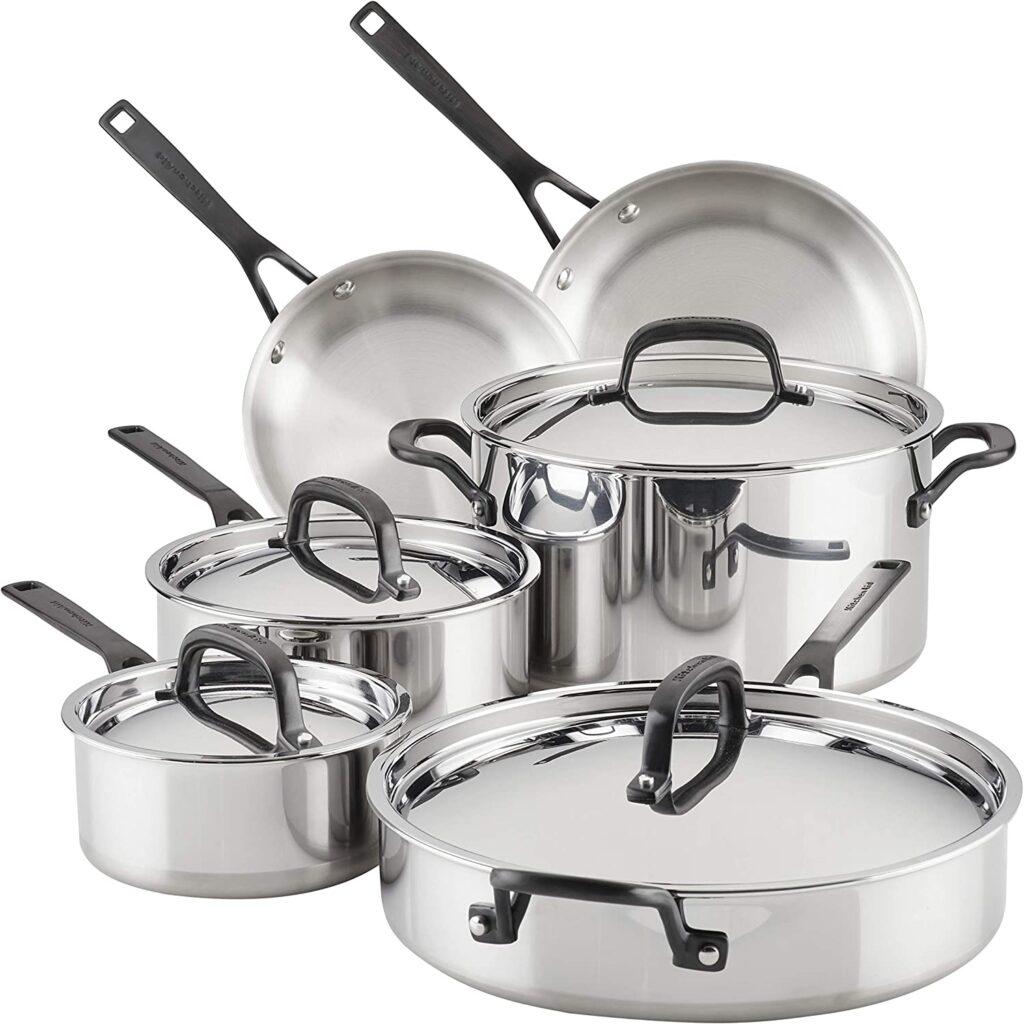
Stainless steel cookware is the most popular type of cookware because of its durability and easy-to-clean properties. It’s often seen in commercial kitchens, where it can handle high heat levels and large quantities of food. The stainless steel material doesn’t react with food, making it safe to use. This makes stainless steel cookware ideal for both stovetop and oven cooking.
The stainless steel material is also heat-resistant, which makes it ideal for cooking at high temperatures. Stainless steel cookware can be used for Dutch ovens, frying pans, casseroles, skillets, saucepans, and other types of pots and pans. Stainless steel cookware is dishwasher safe, which makes it easy to clean. When cleaning stainless steel cookware by hand, be sure to wash it with soapy water before washing with dishwasher detergent.
Merits
- Corrosion-resistant and durable.
- Resists staining.
- It does not react to different foods.
- It is simple to clean and maintain.
- To help with heat transfer and distribution, it may have a multi-ply design.
Demerits
- The metal piece that makes up a heat conductor is too hot.
- Hot spots and scorching are common in this type.
Cast Iron Cookware
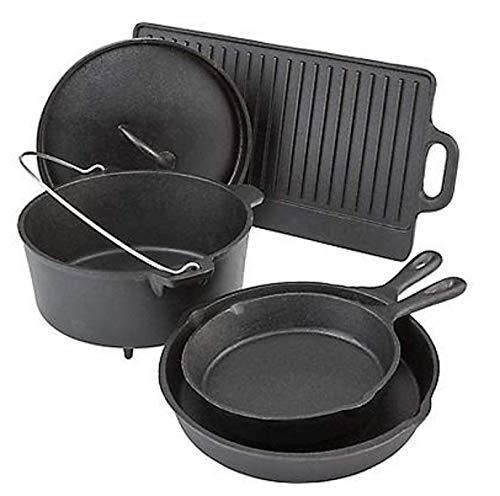
Cast iron cookware is a popular cooking option because it offers a number of benefits, including non-stick cooking and durability. With cast iron cookware, you can slow-cook your food over low to medium heat without worrying about burning it. This is a great option for those who like their food cooked slowly or don’t want to use oil.
Additionally, cast iron cookware can be used for baking or braising. This makes it a good choice for people who like to cook using high heat but don’t want to use oil. This cookware is a great option if you want a nonstick surface or if you need something that will retain heat well. Its rust-resistant qualities make it an ideal choice for outdoorsy types who may take their cooking activities into the wild.
One drawback of cast iron cookware is that it can be difficult to clean. Additionally, cast iron cookware tends to be heavier than other types of cookware, so it may not be easy to move from stovetop to oven or vice versa.
Overall, cast iron cookware is a great option for those looking for non-stick cooking and durability without the weight of stainless steel or aluminum.
Merits
- Durable.
- A good heat conductor.
- Maintains the temperature perfectly.
Demerits
- Heavy.
- If not maintained and dried at all times, rusts will form.
- To maintain a non-stick surface, the pan must be seasoned.
Aluminum Cookware
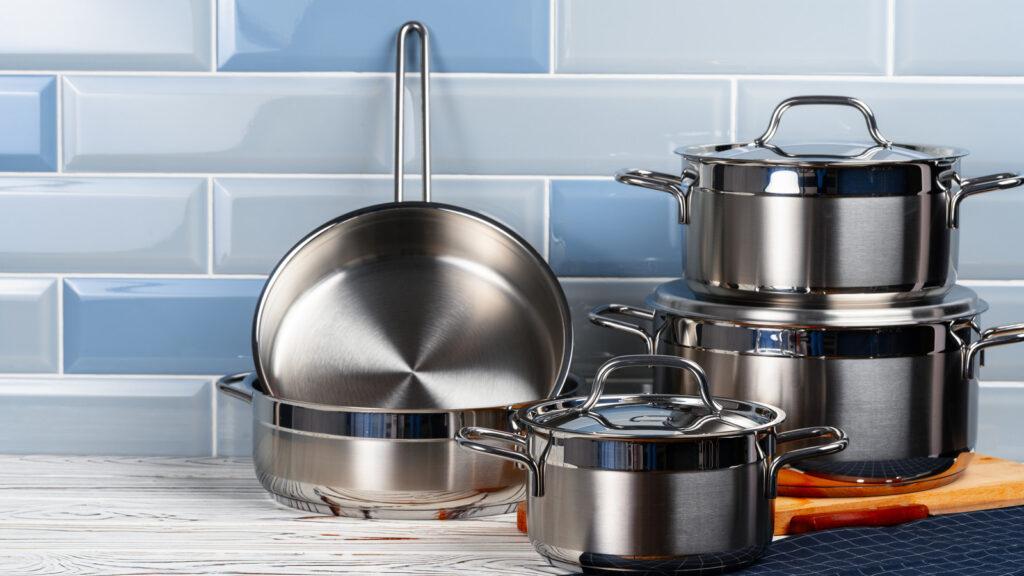
Aluminum cookware is a popular choice for those who want durable and easy-to-clean surfaces. The aluminum is non-stick, so food doesn’t stick to the pans. This makes it easy to cook with little oil or butter. It’s lightweight and easy to move around, making it a great option for busy households. There are a variety of sizes and designs of aluminum cookware available, from Dutch ovens to cast iron pans.
Aluminum cookware can be used on all types of stovetops, from induction stoves to stovetop grills. It’s safe for use with heat sources ranging from gas to electric cooktops, making it a versatile cooking option for any kitchen. Overall, aluminum cookware is a great choice for anyone looking for durable and easy-to-clean cooking surface.
Merits
- Heat conducts readily through it.
- It’s lightweight and simple to control.
- Affordable.
Demerits
- The skin tends to discolor easily.
- Foods that are acidic cause it to react.
Copper Cookware
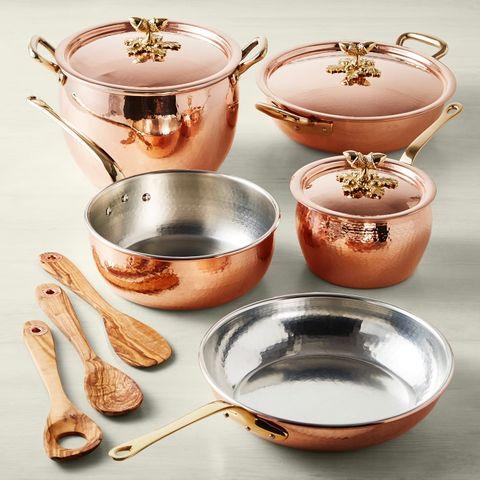
Copper cookware is the optimum material type for ensuring consistent heat distribution out of all the materials. They’re also a excellent option for buffet and restaurant with open cooking concepts since they’re one of the most visually appealing materials. You should only purchase copper cookware that is lined with another material like steel or tin to ensure that it is safe and non-toxic to use.
Merits
- For cookware, the best heat conductor is copper.
- Visually appealing.
- Oven-safe.
Demerits
- Expensive.
- It has a flexible nature that allows it to be bent and distorted.
- It may produce poisonous chemicals when reacts with certain foods.
Glass Cookware
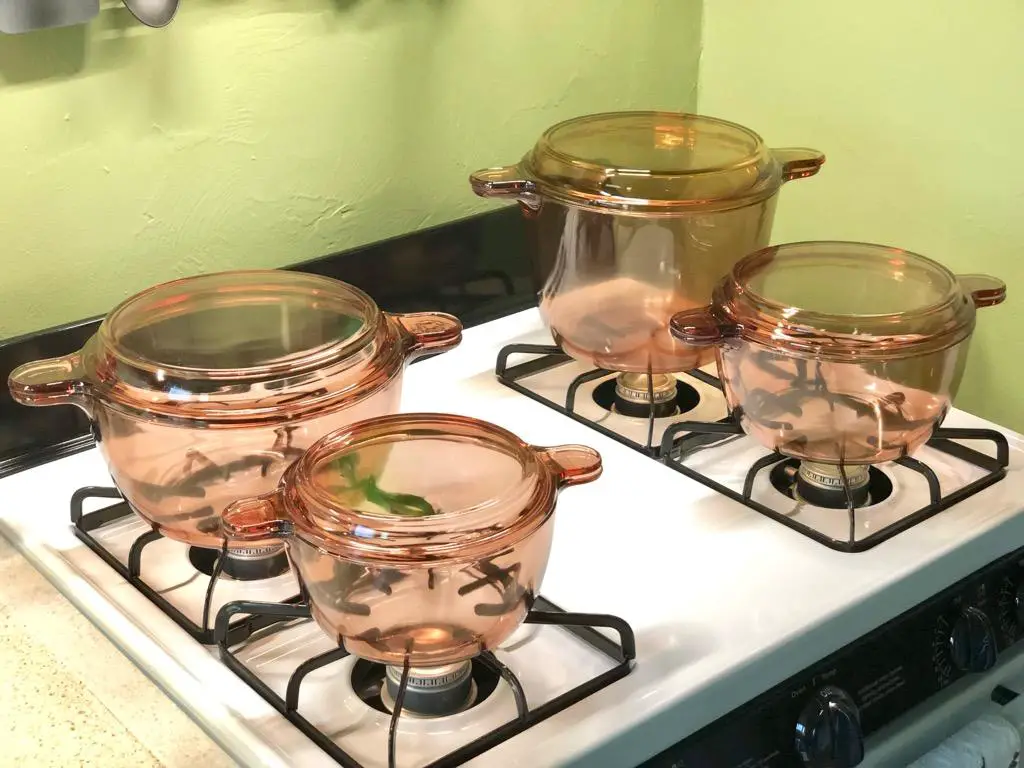
Glass cookware is a popular type of cookware because of its lightweight, durable, and easy-to-clean properties. They are heat-resistant, making it perfect for searing or frying foods. Nonstick coating is also popular on glass cookware, making it easier to clean and preventing food from sticking to the pan. Some glass cookware comes with a nonstick coating, making it easier to avoid scrubbing and cleaning as often. However, nonstick coating can be a potential health hazard if not properly used.
Some glass cookware is oven-safe up to 600 degrees Fahrenheit, as they are made out of tempered glass. This makes it an ideal choice for cooking foods such as cookies or casseroles without needing to use a stovetop or oven. Finally, glass cookware is not as prone to breaking as other types of cookware. While this makes it more durable and long-lasting, it also means that you need to be extra careful when using it.
Merits
- Easy to clean and handle.
- Does not stick the food.
- Lightweight and easy to maintain.
Demerits
- Have to be extra careful, might break if it fall.
- Not a good idea to use it in the dishwasher.
Cast Aluminum Cookware
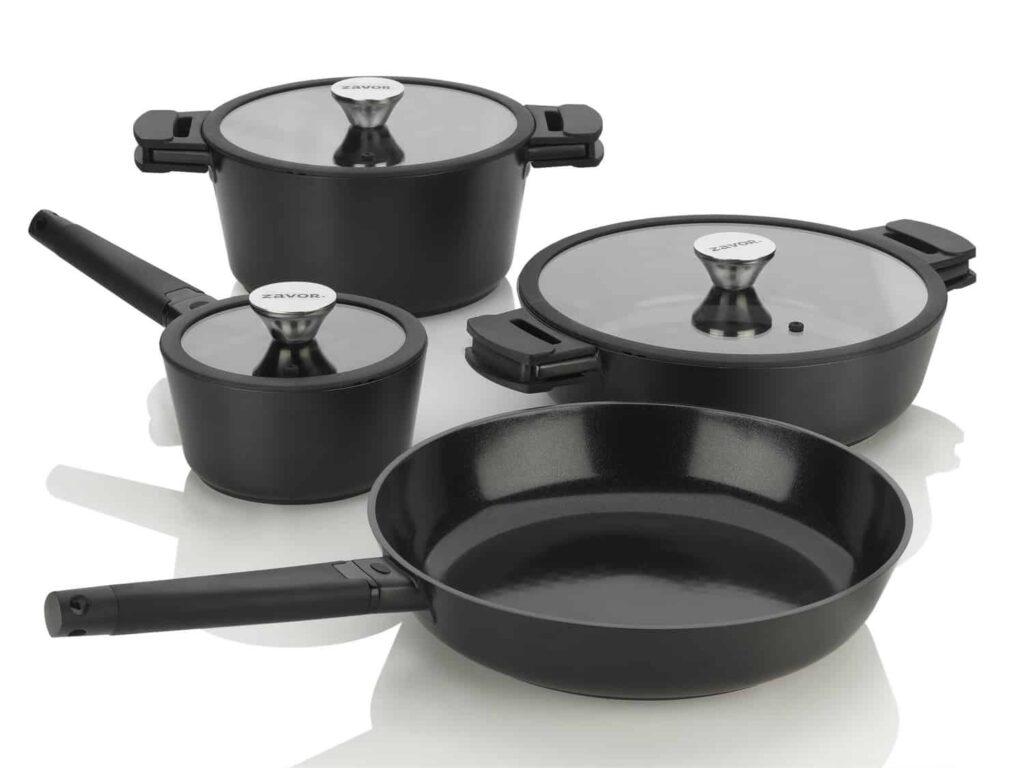
Cookware made of cast aluminum is heat-conducting and keeps it well, as well as being quick to cool. Many are lightweight, making them ideal for handling, and have a durable, food-safe ceramic enamel finish that prevents sticking and corrosion for extended use. In addition, induction cooktops are compatible with cast aluminum cookware, which is oven safe.
Merits
- It does an excellent job of conducting and retaining heat.
- Lightweight.
- Alternative to cast iron that is reasonably priced.
- Rust and sticking substances are resistant to it.
Demerits
- Warps easily.
- Changes the flavor of food, which may be acidic.
Ceramic Cookware
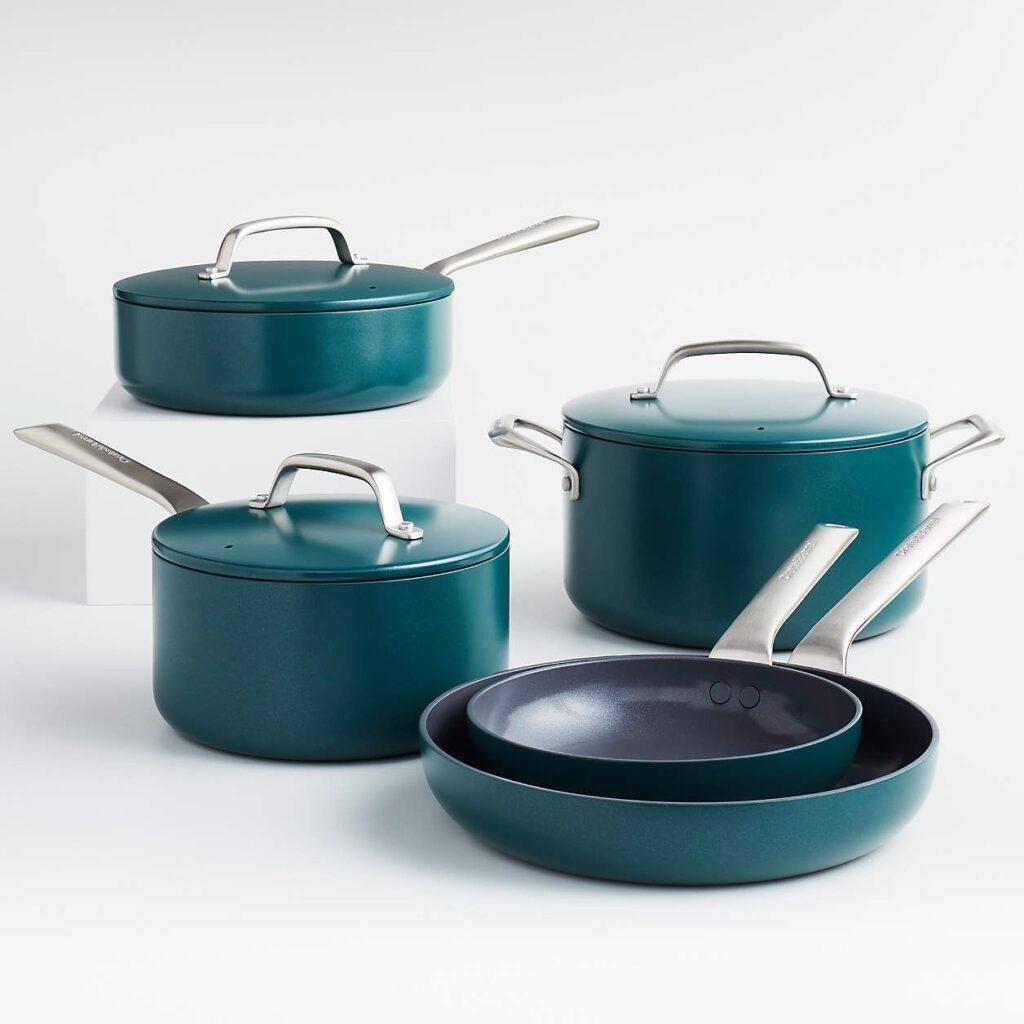
Ceramic cookware is a popular choice for people who want to avoid aluminum and steel cook material. It’s non-stick and dishwasher safe, making it easy to clean and durable for use. Ceramic cookware is visually appealing, making it a good choice for kitchens of all types.
It heats evenly and can be used with any type of cookware, making it versatile and easy to use. Ceramic cookware is also a good value for the money. It provides excellent performance at a price point that’s easy on the budget.
Merits
- Easy to clean.
- Durable.
- Versatile and easy to use.
Demerits
- Heavy.
- Might break after falling.
Porcelain Cookware

Porcelain cookware is a popular choice for those who want to cook delicate foods. That’s because porcelain cookware is non-reactive and easily cleanses. It’s also durable and stain-resistant, making it the perfect material for cooking foods like eggs, fish, and vegetables. The material of porcelain cookware is also non-stick, making cooking easy and quick. That makes it convenient to use and clean.
Some porcelain cookware comes with a nonstick coating that makes cooking even easier. The coating also makes sure that foods don’t stick to the pan, making it a great choice for anyone looking for a high-quality pan at a reasonable price. Porcelain cookware is dishwasher safe, which makes it convenient to use and clean.
Merits
- Easy to use and clean.
- Foods don’t stick to the pan.
- High-quality pan at a reasonable price
Demerits
- Heavy.
Types of Coating
There are a few types of cookware coating that might be of interest to you. Let’s talk about them.
Non-stick Cookware
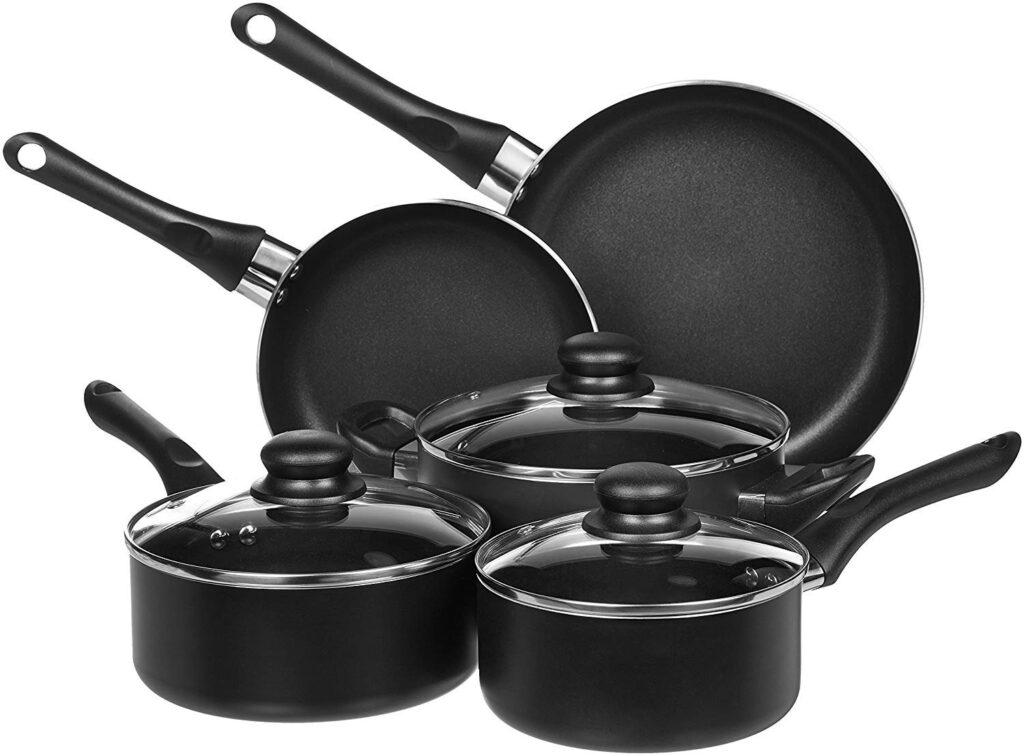
Non-stick cookware is a great option for people who are looking for an easy and fuss-free cooking experience. These types of cookware are designed to be durable, dishwasher safe, and easy to use. They’re available in a variety of shapes, sizes, and colors, making it easy for anyone to find the perfect non-stick pan for their needs.
Non-stick cookware is also known as non-cal cooking spray. It’s made of PTFE (polytetrafluoroethylene) or another non-stick coating that prevents food from sticking to the pan. That makes it easy to clean after cooking is complete.
Non-stick cookware can be used with both induction and conventional ovens. Plus, it’s a good choice for people with food allergies or sensitivities due to its non-allergenic properties. Overall, non-stick cookware is a versatile option that can enhance your cooking experience and make cleaning dishes a breeze!
Marble Coated Cookware

Marble coated cookware is also a great option for people who are looking for high-quality nonstick cookware. These pans come in a variety of colors and materials, making them versatile and durable.
Each pan is heat-resistant up to 600 degrees Fahrenheit, so you can use them with both induction ovens and conventional ovens without fear of damaging the pan or your stovetop. They’re also dishwasher safe, so cleaning them is easy and quick.
One downside of marble coated cookware is that it’s not as nonstick as some other types of cookware. However, it’s still a great choice for people who want high-quality cookware that will last long and provide easy cooking experience.
Teflon Coated Cookware
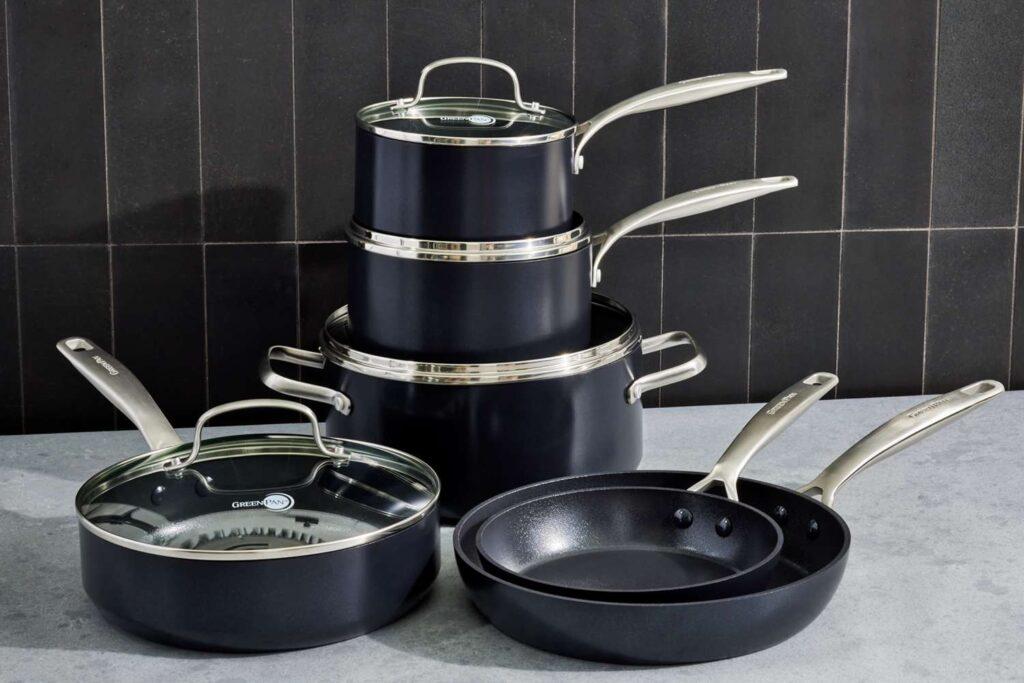
Teflon coated cookware is a great option for people who want the most nonstick cookware possible. These pans are heat-resistant up to 700 degrees Fahrenheit and can be used with conventional ovens or induction ovens. They also come in a variety of colors and materials, so you’re sure to find one that suits your needs.
One downside of Teflon coated cookware is that it’s not as durable as marble or stainless steel pans . However, it still provides good cooking experience and long-term durability. Plus, it’s easy to clean – just throw it in the dishwasher! Finally, Teflon-coated cookware uses a nonstick coating that doesn’t wear down over time. These non-sticking surfaces help reduce the need for oil or butter during cooking, which makes them a healthy alternative to traditional nonstick pans.
Granite Coated Cookware

Cookware with carbon steel, aluminum, or stainless steel cores finished with high-end and extremely durable nonstick coatings is referred to as ‘granite cookware.’ Even after years of use, food glides around the pan and nothing sticks. It is PFOA-Free. Even if it is accidentally overheated, the healthy mineral nonstick coating will never emit toxic fumes because it is free of PFAS, PFOA, lead, and cadmium.
There are several benefits to granite stone cookware. For example, if the porcelain coating isn’t damaged, it is healthy and non-toxic. It’s light weight, waterproof, and simple to clean. Low and medium-heat cooking is ideal for granite cookware. Granite coated cookware is a great option for people who want high-quality nonstick cookware that will last long. These pans are heat-resistant up to 900 degrees Fahrenheit and can be used with both induction ovens and conventional ovens.
Cookware Accessories
To help your chefs stay safe and work spaces clean, cookware accessories may enhance the functionality of your current pots and pans. Even with a small kitchen, some accessories may aid in bringing dishes to the table!
Pot and Pan Lids

- During the cooking process, this is an ideal sealer of heat.
- To keep your cooktop clean, it reduce spatter.
- Water inside pots or pans is circulated by domed lids.
Wok Rings
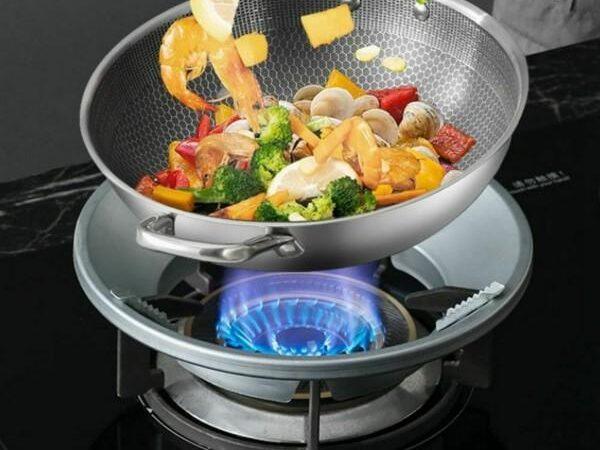
- To support round-bottomed woks, place them on top of a burner.
- The heat is concentrated and directed in the ventilated design.
- Make sure your table isn’t tipping or wobbling.
Handle Covers
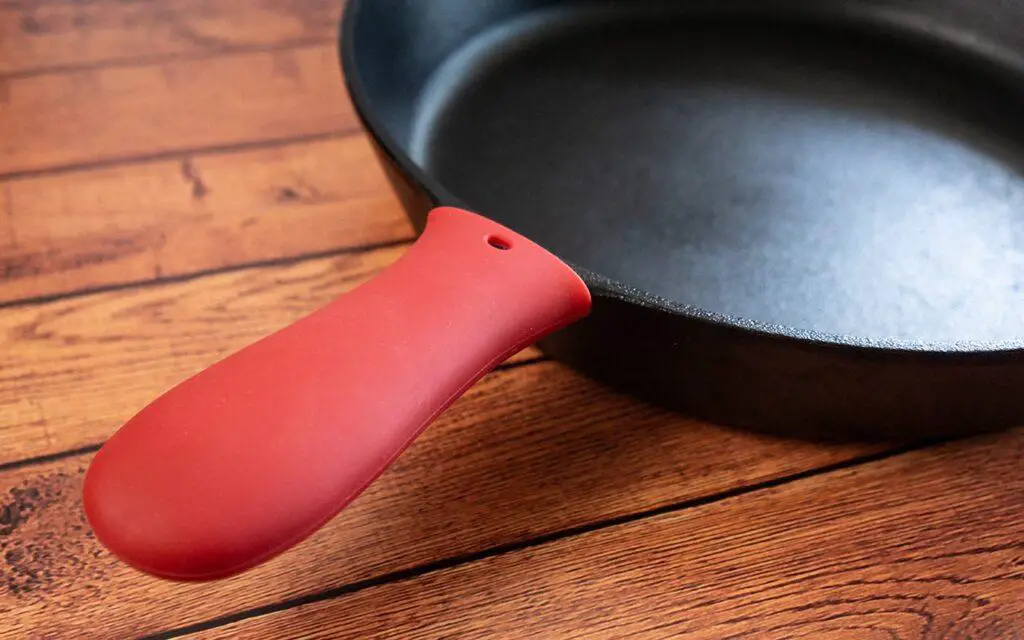
- To keep a cool touch, the handle is made of heat-resistant silicone.
- Easy cleaning is facilitated by the slides that go on and off.
- It provides extra cushioning.
Steamer Basket
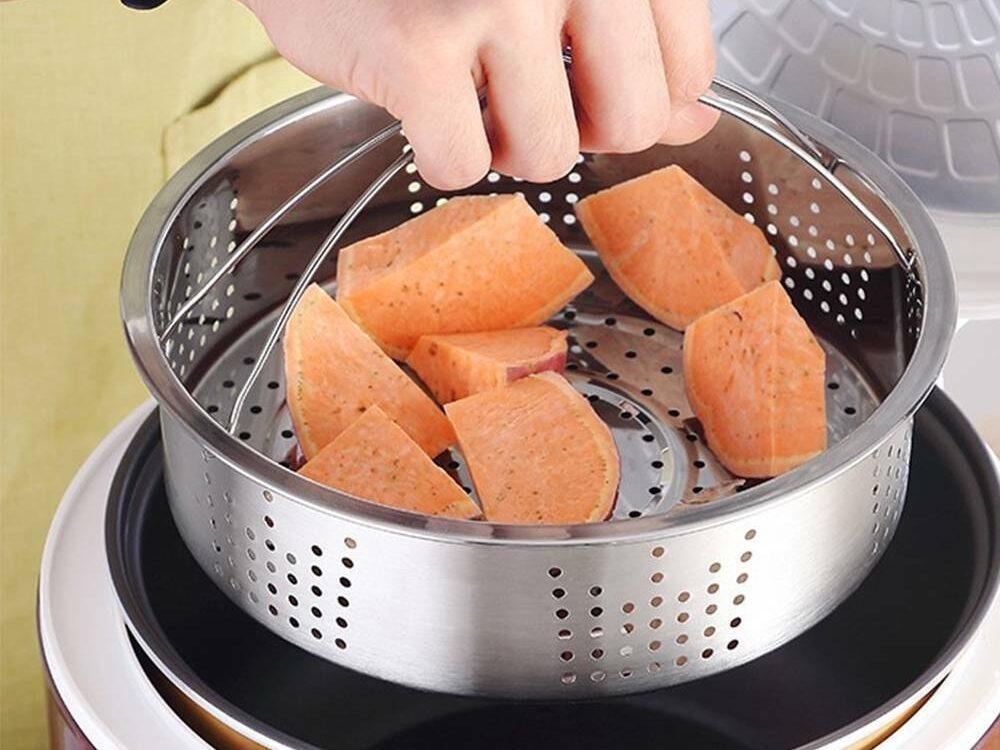
- Fryers, steamers, and pasta cookers are all built from stock pots.
- Cooked foods like vegetables and chicken are often steamed.
- Also great for blanching veggies.
Splatter Screens
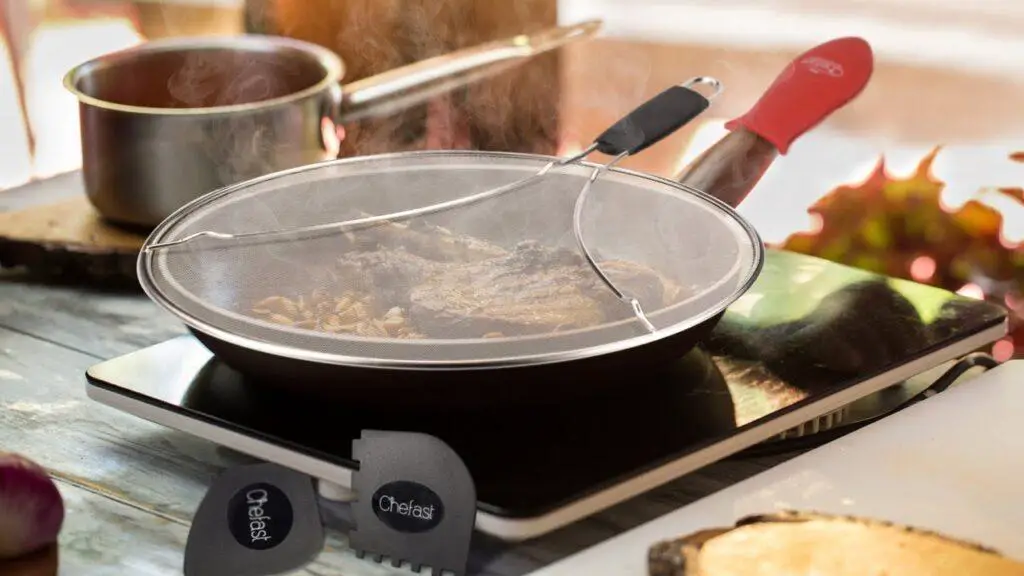
- There is no such thing as a bad mesh.
- Oil and grease splashes are prevented while food is able to breathe.
- In the kitchen, it aids in preventing oil burns and other injuries.
Culinary Baskets
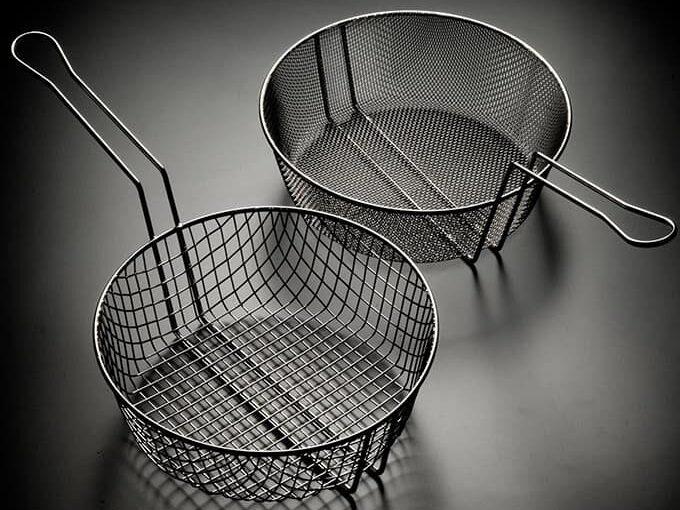
- Frying, boiling, blanching, and skimming are all ideal uses for this pan.
- Both coarse and fine mesh versions are available.
- When cooking, keep hands away from the heat.
Egg Poachers
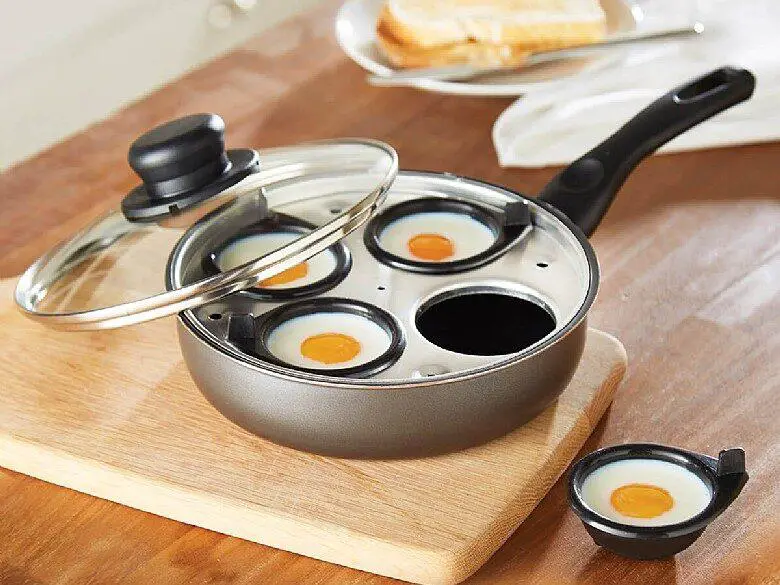
- Simplify the egg poaching procedure
- Evenly-shaped poached eggs are consistently provided in individual cups.
- For high-volume efficiency, models with 4 to 15 cups are available.
Stove Top Griddles
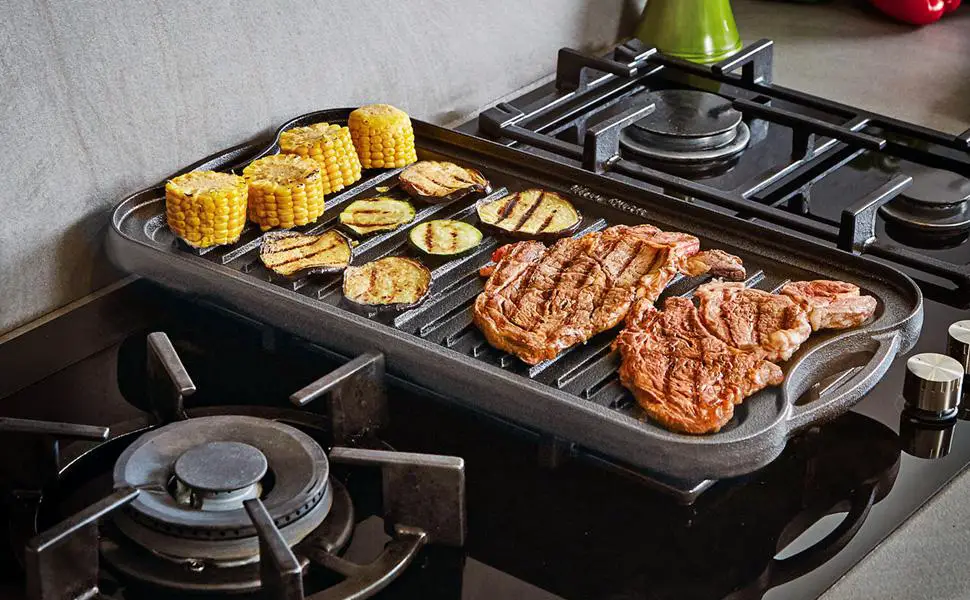
- Makes a griddle or grill out of a section of a stovetop.
- Easy placement and transportation are guaranteed with these handles.
- In cooking applications, smooth, ribbed, and reversible designs offer versatility.
Steamer Racks
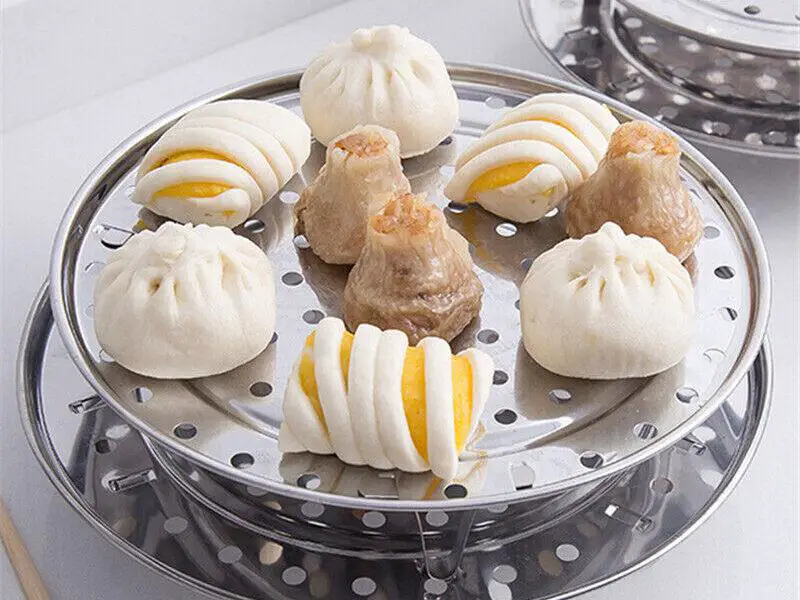
- Can fit into stock pots, pressure cookers, and skillets.
- Prevents food from falling to the bottom of the pan.
- Ideal for steaming fresh produce, fish, and tamales.
Cookware Care and Maintenance
When it comes to caring for cookware, there are a few basic guidelines to follow. Avoid using scouring pads or harsh abrasives on the cookware, as this can damage the surface and lead to discoloration. Always use a neutral detergent and lukewarm water when cleaning the cookware, and never put it in the dishwasher. Also, store the cookware in a cool, dry place, and don’t use aluminum cookware on an induction stovetop.
Apart from these basics, you can take care of your cookware by wiping it clean after every use and coating it with a non-stick cooking spray once every few months. Overall, following these simple tips will help you maintain your cookware and enjoy good-quality cookware for years to come. You can also follow the instructions given by the manufacturers.
Cookware Storage Tips
Storing cookware correctly is vital to ensuring that it lasts as long as possible and provides the best possible cooking experience. Here are some tips to help you keep your cookware organized and in good condition:
- Keep your cookware clean by washing it with a dishwasher or hand wash.
- Use non-stick cookware only on non-stick cooktop surfaces, such as steel griddle or non-stick skillet.
- Use stainless steel cookware for high heat cooking and cast iron for slower cooking.
- Use silicone utensils for non-stick cookware. Nylon utensils are not durable and can damage non-stick surfaces.
- Do not use metal utensils on non-stick surfaces as this can cause scratches.
- Use PTFE (Teflon) utensils with non-stick cookware as these utensils won’t scratch the surface of the pan.
- Stick to safe cleaning practices when using non-stick cookware, keeping it free of rust and aluminum oxide buildup. Also, avoid using high heat when cooking with non-stick cookware, as this could lead to hot spots or discoloration of the surface of the pan.
Cookware Market Segment Analysis
People’s attitudes toward health and the kitchen environment have changed dramatically as a result of the COVID-19 pandemic. In 2021, the global cookware market was estimated to reach USD 23.75 billion, with a CAGR of 6.5% over the next decade, according to projections. Several pivoting elements, such as working from home and buying products online, have changed the way that people spend money on cookware, giving them more spending freedom.
Moreover, owing to the rising popularity of consumers toward modular kitchens, increased spending on home improvement projects or home remodeling is boosting product demand. Home renovation spending has increased at a pace of 6% per year in the previous three years, according to the Leading Index for Remodeling Activity. Furthermore, with suitable cookware items in the kitchen, manufacturers are working with builders and contractors to build homes.
Consumers are increasingly demanding sustainable products as a result of concerns over climate changes and deforestation. Sustainable cookware is in high demand right now, especially since it is free of glues, polymers, coatings, and dyes. Consumers want sustainable goods with a visual appeal, in addition to those that are sustainable.
Pots and Pans Market Value
With a share of almost 30.0% in 2021, the pots and pans segment dominated the market in terms of value. Due to the popularity of multi-purpose and colorful pots, the segment is expected to expand steadily over the next few years. Consumers should be able to purchase pans and pots that meet their needs, rather than having to purchase multiple products. Consumers favor products with different characteristics, designs, and colors.
From 2022 to 2030, the cooking utensils industry is projected to have the highest growth rate at 7.7%. The constant rise in demand for spoons used for cooking and serving is credited with the rising demand for these goods. Stainless steel spoons are available from cookware manufacturers, which are produced to have a longer lifespan and may be plated with various materials depending on the design requirements and usage.
Now, we have data according to the consumer’s choices. If consumers in the United States were considering a cookware purchase over the next 12 months, this statistic indicates which cookware items they would most likely acquire. According to the poll, 69.4 percent of Americans approve of the president. If consumers were to buy cookware in the next 12 months, a frying pan would be the most likely purchase. Then comes the saucepan at 50.4%, 8-piece cookware set at 44.3%, stockpot/soup pot at 36.1%, and so on.
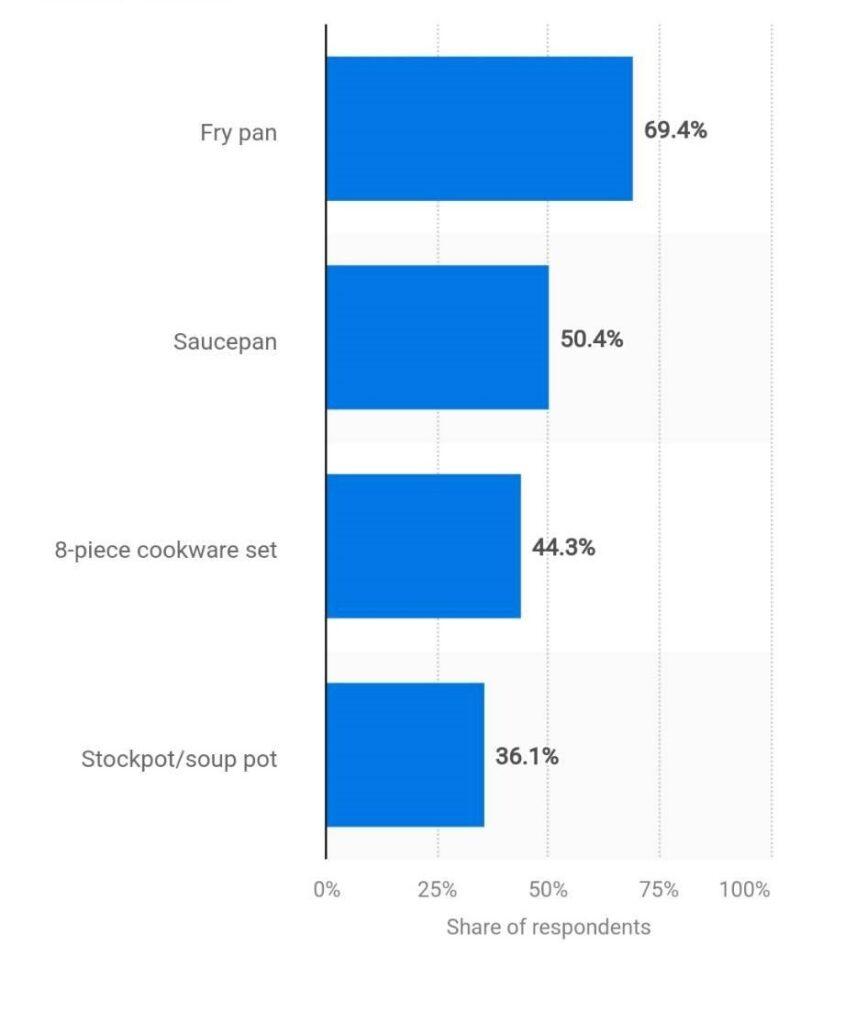
Essential Pans and Pots for any Home Cook
The truth is that only think ten pots and pans are necessary for any home kitchen. With the help of this ingredients, you can make almost the same recipe for your family. Therefore, I compiled a list of pots and pans that I discovered to be essential for any home cook.
- Cast iron skillets.
- Large stainless steel frying pan.
- Large Nonstick skillets.
- Small or medium nonstick skillets or frying pan.
- Medium stainless steel stockpot.
- Small saucepan.
- Dutch oven.
- Baking sheets.
- 9*13 baking dish.
- Pasta pot.
Frequently Asked Questions
How do Different Types of Cookware Work?
Different types of cookware work best for different cooking methods. Here’s a list of the most popular types of cookware, and their corresponding cooking methods:
- Cast-iron cookware is best for braising or searing meat.
- Stainless steel cookware is best for baking and frying.
- Teflon coated cookware is best for slow cooking.
- Ceramic cookware is best for making savory or sweet dishes.
- Glass cookware is best for oven cooking and pan frying.
- Silicone cookware is non-stick, durable, and heat resistant.
- Dual-purpose cookware can be used for both stovetop and oven cooking methods.
What are the Benefits of Using Different Types of Cookware?
There are many types of cookware out there, and each has its own unique set of benefits.
- Ceramic cookware is best for slow cooking and baking. It heats evenly and doesn’t break down over time like other types of cookware. It can also hold heat very well, Meaning you can cook foods slowly or at low temperatures for a long period of time without them sticking to the pan or burning.
- Stainless steel cookware is best for searing and frying. It’s durable and non-stick, making it ideal for searing meat or frying foods. It’s also ovensafe to 350 degrees Fahrenheit, so you can use it to cook in the oven as well.
- Cast iron cookware is best for braising and searing. It retains heat well and is oven-safe up to 500 degrees Fahrenheit. This means that you can cook your favorite cast iron dish, such as pot roast or chicken breasts, in the oven without them getting overcooked or dried out.
- Lastly, aluminum cookware is best for fast cooking and baking. It heats up quickly and evenly, making it perfect for making breakfast, lunch, or dinner on the go. It’s also dishwasher safe, so cleanup is a breeze!
What are the Advantages and Disadvantages of Each Type of Cookware?
There are a number of advantages and disadvantages to each type of cookware, so it is important to choose the type of cookware that best suits your needs. The main advantages of stainless steel cookware are that it is durable and doesn’t corrode. Nowadays, it has been the most selling cookware worldwide. It also heats evenly and is easy to clean. Disadvantages of stainless steel cookware include that it can be difficult to keep clean, and it may not be as aesthetically pleasing as other types of cookware. Teflon-coated cookware is popular because it is non-stick and heat-resistant. However, it can be difficult to clean and can release harmful chemicals when heated.
Cast iron cookware is classic and traditional, and has many advantages, such as being durable and non-toxic. It can take a while to heat up, but once it is hot, it cooks food evenly and slowly. Disadvantages of cast iron cookware include that it can be heavy and difficult to move around, and it can be expensive. Ceramic cookware is a recent invention that combines many of the benefits of other types of cookware. It is non-stick, heat-resistant, and easy to clean, but it may not be as durable or classic looking as new.
Conclusion
Cookware is one of the most important kitchen essentials, and there are a variety of different types available on the market. By understanding the different types of cookware available, you can choose the perfect set of cookware for your needs. This knowledge will also help you make better food choices and make cooking more enjoyable. In this blog post, we will discuss the different types of cookware available and their benefits. Thank you for reading!
Related Post:

